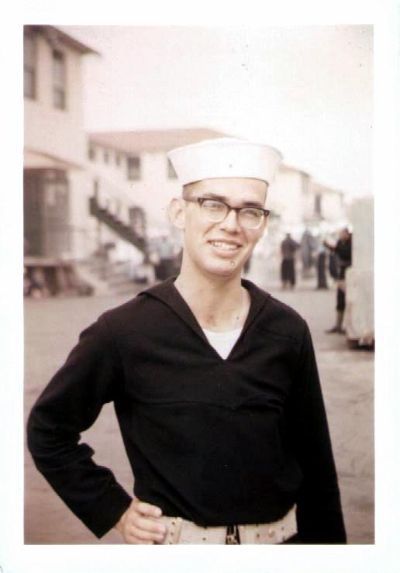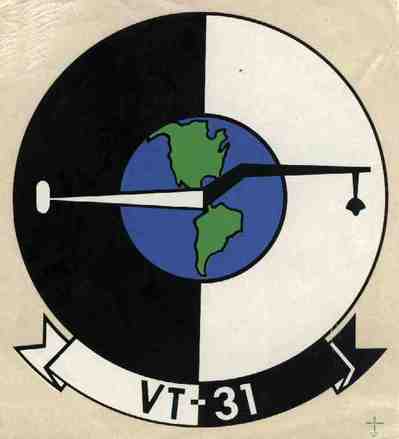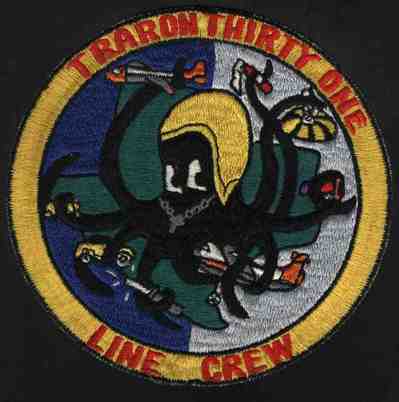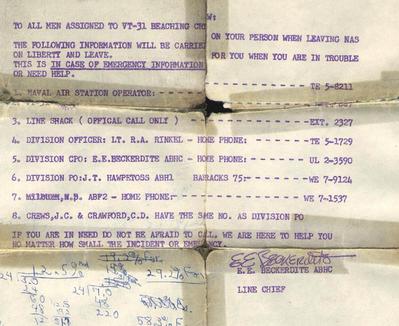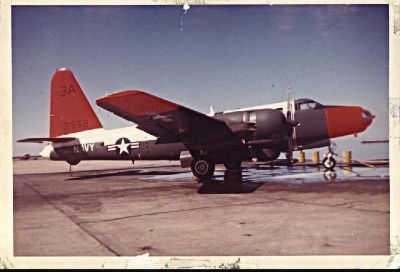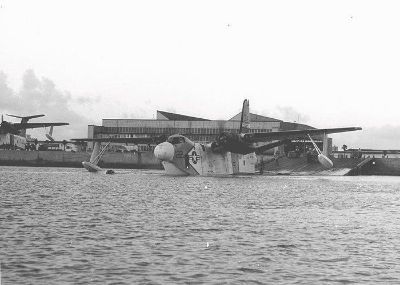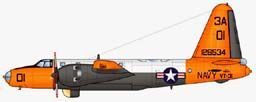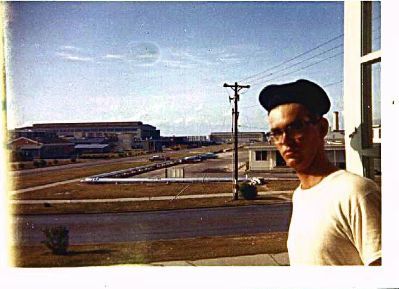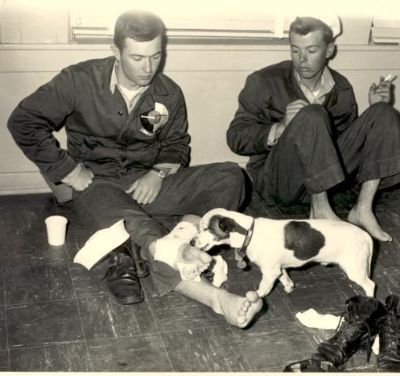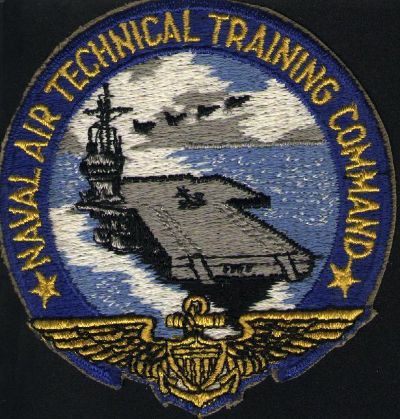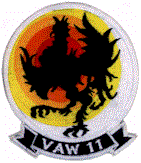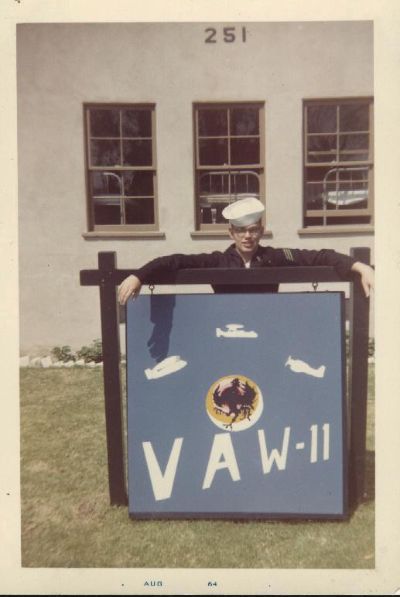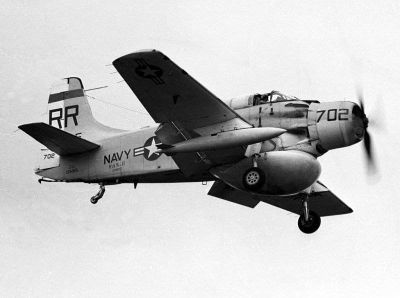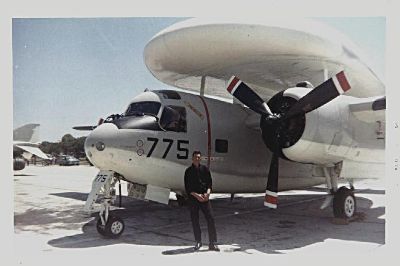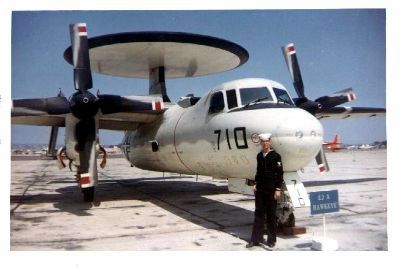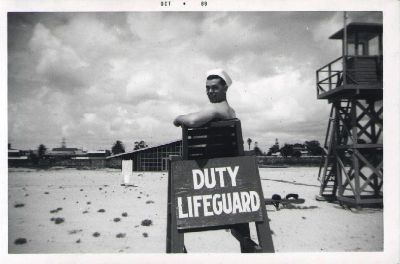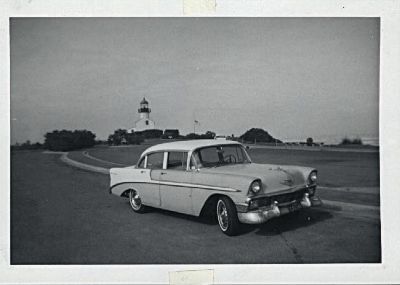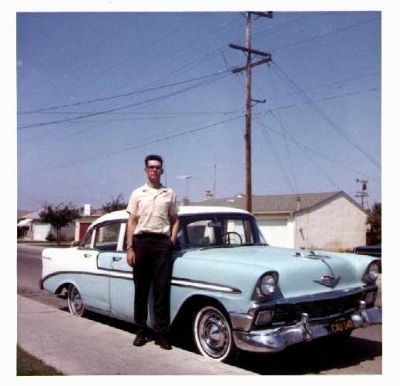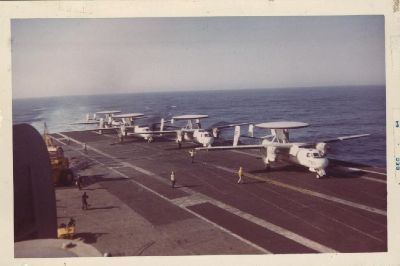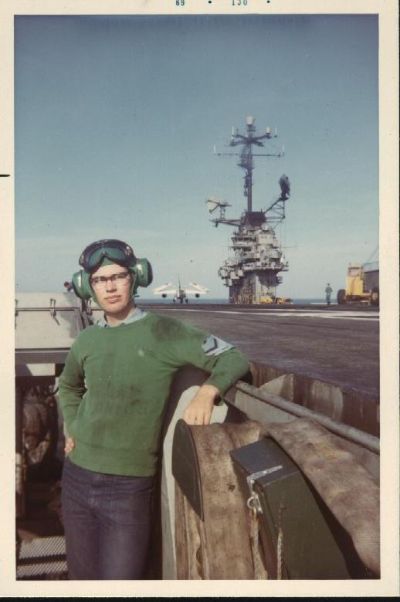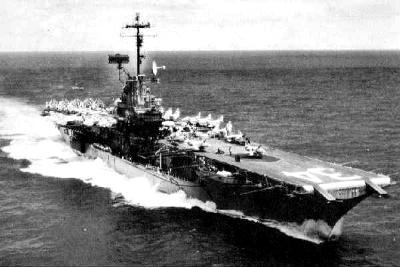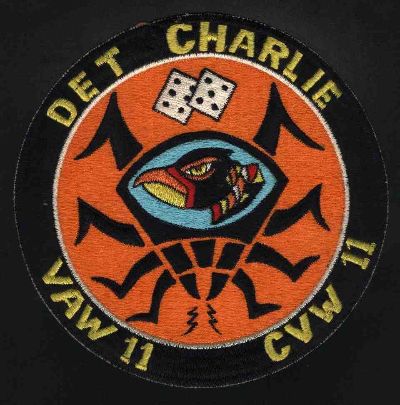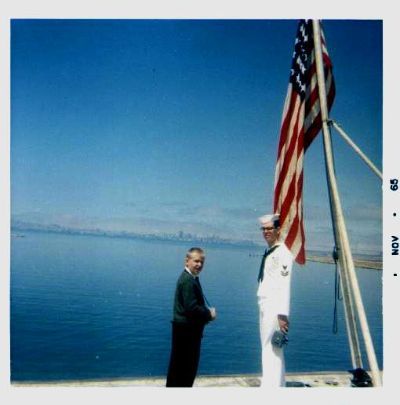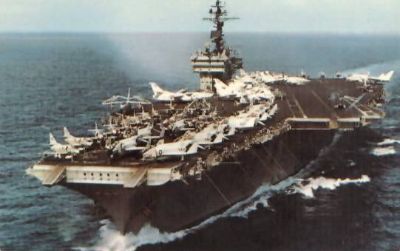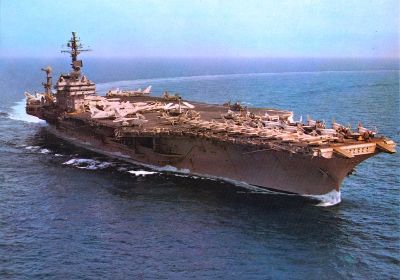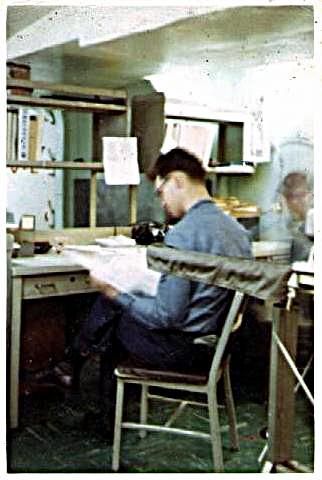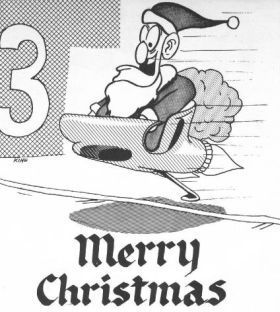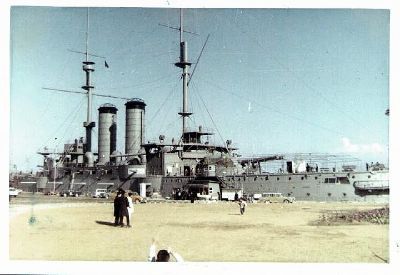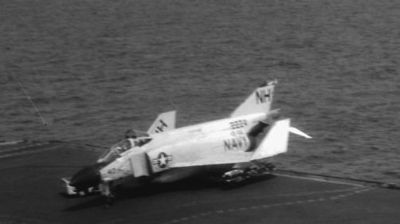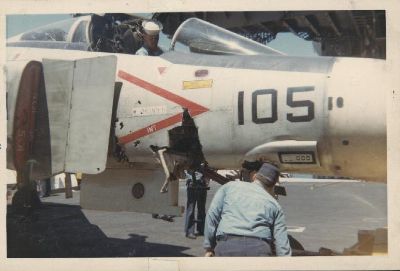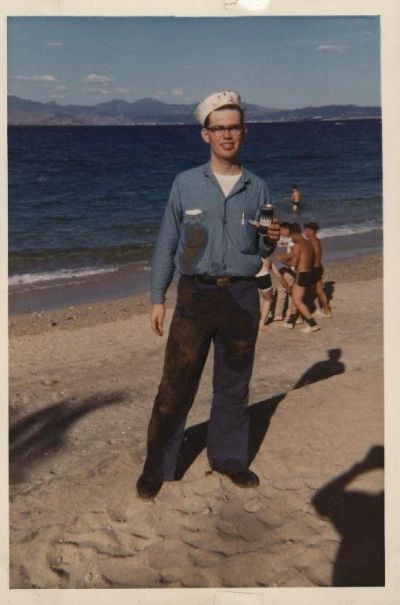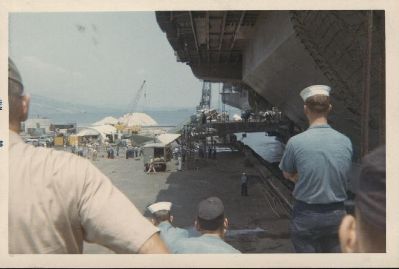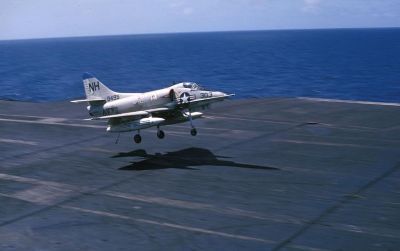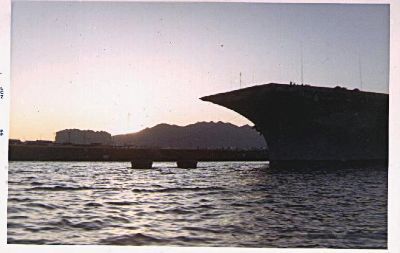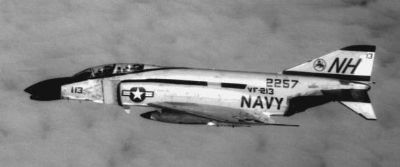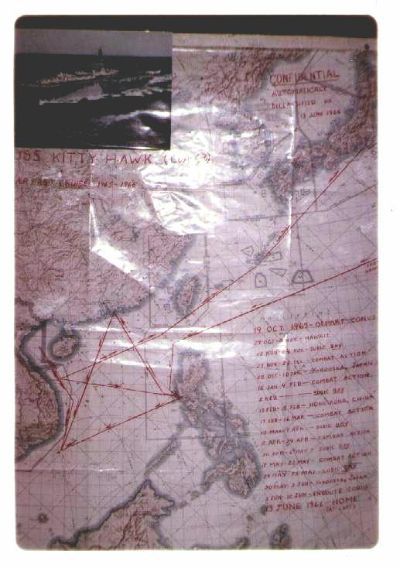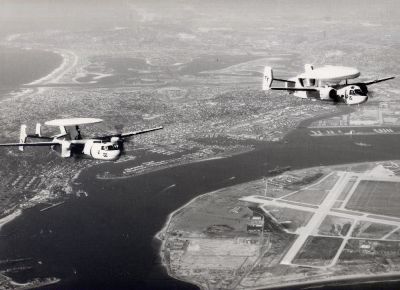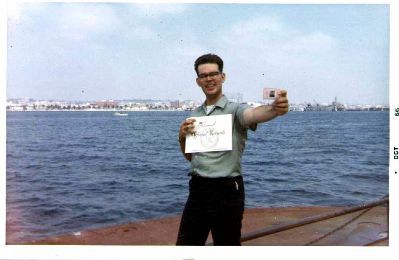I enlisted in the US Navy in mid September of 1962 after graduating from Arroyo High School, San Lorenzo Ca. in June. I chose to wait until September so I could be with friends during the summer and avoid going through boot camp during the hottest days of the year.
I graduated from boot camp in late November (?) and, after a short home leave, reported for duty with VT-31, a pilot training squadron flying P-2 Neptune patrol bombers and P-5 Marlin flying boats out of Corpus Christi NAS on the gulf coast of Texas.
As it was a training command, it was in holiday mode when I arrived in mid December. At first I was not aware of that and thought it was normal. I could learn to like this schedule, I thought. One day of work and two days off. Silly me.
My first job was making coffee in the Chief's lounge at one of our hangers. I had never made coffee before and had probably not consumed more than three cups of coffee in my life. Needless to say, that job didn't last long.
I was then assigned to the Line Crew. Our duties included directing taxi-ing P-2s in and out of our area using "wands", operating the brakes from the cockpit of the P-2s when being towed as well as driving the tow tractors and "walking the wings" during such moves. Walking the wings means walking beneath the wing tips to see that they did not hit anything. We also launched and recovered the P-5s up and down the ramps into the bay. This included attaching and removing the wheel mounts when in the bay while wearing wet suits. Now that was almost fun but you had to watch out for the jelly fish. We worked in shifts as we were needed day and night.
My first job was making coffee in the Chief's lounge at one of our hangers. I had never made coffee before and had probably not consumed more than three cups of coffee in my life. Needless to say, that job didn't last long.
I was then assigned to the Line Crew. Our duties included directing taxi-ing P-2s in and out of our area using "wands", operating the brakes from the cockpit of the P-2s when being towed as well as driving the tow tractors and "walking the wings" during such moves. Walking the wings means walking beneath the wing tips to see that they did not hit anything. We also launched and recovered the P-5s up and down the ramps into the bay. This included attaching and removing the wheel mounts when in the bay while wearing wet suits. Now that was almost fun but you had to watch out for the jelly fish. We worked in shifts as we were needed day and night.
I guess I was a bit of a smart ass. Not that I was disrespectful but I knew more about the specs of Navy aircraft and ships than the petty officers and often demonstrated this fact during our spare time. They called me on it one night and quizzed me on my knowledge in front of the entire crew. I nailed them to the wall. This led to a sideways at best career move (dern petty petty officers) to a small group in charge of maintaining air pressure in all the P-5 wheel mount tires and washing all the aircraft. OK duty but not as glamorous as Line Crew duty.
Still, it was not so bad if only because I was with some very interesting fellow sailors. I believe the chief in charge was Ferris. There was perhaps one first class and one second class petty officer and three or four of us swabbies. Chief Ferris was a true "old salt" and had been busted a few times, as I recall. The first class PO was a large man who was approaching saltiness. I seem to recall the second class PO joined the Navy only because he was given the choice of the Navy or jail when he was caught with someone important's wife. By the way, these recollections are a bit vague.
I believe the three POs and a couple of us swabbies were from the deep South, my first introduction to that culture as I was from the San Francisco / Oakland Bay Area. One of the southern swabies was a small black man named Pickney. He seemed to be an all right guy but apparently his experiences with racial intolerance made him a bit paranoid. One day Pickney and I were sent out to the wash rack to wash a P-2. (See picture above of P-2 on that "rack") He wasn't interested in talking to me that day. He was a man of few words anyhow but we needed to discuss who was going to do what, so I suggested he do this while I do that. Next thing I knew, he was gone.
I worked by myself for maybe 15 minutes and then went back to our "office", really a small two room shack behind a hangar, to find out what was going on. He wasn't there but apparently had been as the chief and the first class PO were very upset with me. I was accused of racial discrimination or worse and that if I didn't fly right, it would be Captain's Mast time. I was shocked. Telling them what really did and did not happen got me nowhere so I got to wash that P-2 by myself. One thing I found very interesting, in a positive way, about the incident was that these southern rural "good old boys" jumped to Picney's defense. It seems among Navy "lifers" we were all Navy and there was no racial intolerance allowed. Or/and perhaps, at least in the Navy, Southerners stuck together. We all got along well enough after that.
I believe the three POs and a couple of us swabbies were from the deep South, my first introduction to that culture as I was from the San Francisco / Oakland Bay Area. One of the southern swabies was a small black man named Pickney. He seemed to be an all right guy but apparently his experiences with racial intolerance made him a bit paranoid. One day Pickney and I were sent out to the wash rack to wash a P-2. (See picture above of P-2 on that "rack") He wasn't interested in talking to me that day. He was a man of few words anyhow but we needed to discuss who was going to do what, so I suggested he do this while I do that. Next thing I knew, he was gone.
I worked by myself for maybe 15 minutes and then went back to our "office", really a small two room shack behind a hangar, to find out what was going on. He wasn't there but apparently had been as the chief and the first class PO were very upset with me. I was accused of racial discrimination or worse and that if I didn't fly right, it would be Captain's Mast time. I was shocked. Telling them what really did and did not happen got me nowhere so I got to wash that P-2 by myself. One thing I found very interesting, in a positive way, about the incident was that these southern rural "good old boys" jumped to Picney's defense. It seems among Navy "lifers" we were all Navy and there was no racial intolerance allowed. Or/and perhaps, at least in the Navy, Southerners stuck together. We all got along well enough after that.
There was a major brig at the base, run by the Marines. What went on there made boot camp look like trip to Disney Land. I decided not wind up in the brig.
While returning to NAS Corpus Christi from home leave on commercial air (Trans Texas Airlines?) There was one other sailor on the flight. He had his orders with him and seemed a bit depressed. We talked and he told me he was being assigned to the brig, as an inmate. This was my first time at the Corpus Christi airport. I had first arrived in Corpus Christi via Greyhound bus and had flown out on leave in a P-2 from the base. as it turned out, the airport was about as far from the base as it could be and still be Corpus Christi's airport. short of an expensive taxi ride, I did not know how I was going to get to the base. That would not be so bad if I could have shared a ride with the brig bound sailor but the brig had sent a car with two marines to escort him and they weren't inclined to give me a ride as it might compromise security. The "prisoner" very respectfully asked them to reconsider since he had arrived as ordered, unescorted. they did and I got my ride.
Outside of normal business hours, there were always several of us standing security watch around the hangars and the aircraft on the flight line. During one mid watch, perhaps about 1am, walking slowly from the sea wall towards the street in front of the eastern most hangar, the bay was to the North as I recall, when I heard someone trying to start a car. The starter would turn the engine a bit then there would be a crunching/scraping sound and it would stop. The sound was coming from the street side of the hangar so I suspected I would find someone from our squadron trying to start there car. It sounded like they were not going anywhere soon so there was no rush. When I got to the street side, I noticed a Dodge Dart with it's grill wrapped around a very large palm tree. A civilian woman was inside and in not so good shape. I suspected that she should not be moved. I checked under the car to confirm there was no fuel leakage, gave her my jacket to keep her warm as she seemed to be in shock. Other than her face, there seemed to be no external bleeding. I ran to the watch office to report the incident and returned to wait for base security and medics. It seemed to take them both forever. Then I returned to my "beat". Eventually she was taken away and the car was moved to the parking lot., with my jacket locked inside.
Those that have mid watch get to sleep in an extra hour or two so I missed morning muster. The Captain told everyone at the muster about the incident and how well I had done. To bad I missed it. No, I did not get a medal or promotion ;>
A couple weeks later I got my jacket back with a thank you note from the woman.
While returning to NAS Corpus Christi from home leave on commercial air (Trans Texas Airlines?) There was one other sailor on the flight. He had his orders with him and seemed a bit depressed. We talked and he told me he was being assigned to the brig, as an inmate. This was my first time at the Corpus Christi airport. I had first arrived in Corpus Christi via Greyhound bus and had flown out on leave in a P-2 from the base. as it turned out, the airport was about as far from the base as it could be and still be Corpus Christi's airport. short of an expensive taxi ride, I did not know how I was going to get to the base. That would not be so bad if I could have shared a ride with the brig bound sailor but the brig had sent a car with two marines to escort him and they weren't inclined to give me a ride as it might compromise security. The "prisoner" very respectfully asked them to reconsider since he had arrived as ordered, unescorted. they did and I got my ride.
Outside of normal business hours, there were always several of us standing security watch around the hangars and the aircraft on the flight line. During one mid watch, perhaps about 1am, walking slowly from the sea wall towards the street in front of the eastern most hangar, the bay was to the North as I recall, when I heard someone trying to start a car. The starter would turn the engine a bit then there would be a crunching/scraping sound and it would stop. The sound was coming from the street side of the hangar so I suspected I would find someone from our squadron trying to start there car. It sounded like they were not going anywhere soon so there was no rush. When I got to the street side, I noticed a Dodge Dart with it's grill wrapped around a very large palm tree. A civilian woman was inside and in not so good shape. I suspected that she should not be moved. I checked under the car to confirm there was no fuel leakage, gave her my jacket to keep her warm as she seemed to be in shock. Other than her face, there seemed to be no external bleeding. I ran to the watch office to report the incident and returned to wait for base security and medics. It seemed to take them both forever. Then I returned to my "beat". Eventually she was taken away and the car was moved to the parking lot., with my jacket locked inside.
Those that have mid watch get to sleep in an extra hour or two so I missed morning muster. The Captain told everyone at the muster about the incident and how well I had done. To bad I missed it. No, I did not get a medal or promotion ;>
A couple weeks later I got my jacket back with a thank you note from the woman.
Not surprisingly there were some at the barracks that would go to the base club each night and come back snockered. They would return to the barracks an hour or two after taps. It wasn't so bad that they were a bit noisy but, since I didn't care to go with them or even smoke with them (why would any red blooded American male not smoke?) they usually made sure I was very awake. Nothing too drastic, just kicking my bunk or hitting me with pillows. After considering my options I decided not to be there when they returned from the club. I would sleep in another squadron's barracks next door. They had many empty bunks. Probably against regulations but it worked better than I had hoped. They apparently figured that I was shacking up with some babe in town so now I was "cool". I did that for a week before I was discovered by someone in the other squadron but all they did was run me out after I explained the situation. No more problems.
I was only with VT-31 for 5 or 6 months while waiting for an opening at the Aviation Electronics Technician school at the Naval Air Technical Training Command, Millington Tennessee.
I had purchased a cigarette lighter with the squadron emblem on it. Yeah, I didn't smoke but it came in handy for seeing in my locker at night and lighting cigarettes for others, besides it was cool. A couple of weeks before I left I loaned it to one of the guys I worked with. We were both going to Millington at the same time and he had not returned it before we left. He decided to drive his own car and offered me a ride. I chose to let the Navy fly me there. I made it, he didn't. He died in an accident. I suppose if I had gone with him that accident would not have happened and I would still have my lighter. Oh well, such is life, and death.
NATTC Memphis / Millington.
In June of 1963 I reported for Aviation Electronic Technician training at the Naval Technical Training Command near Millington Tennessee. After two or three weeks of cleaning barracks and bagging groceries at the PX, I started classes. Except for the holidays and a few unscheduled days off in November, it was 8 hours a day, 5 days a week fast paced proficient class room and lab training for six months. It was the most productive training I have experienced.
First we had a week or two of basic aircraft ground crew training much of which was old hat to me with my experience working part time for American Aircraft Sales at Hayward Airport, Hayward California during my senior year of high school and my VT-31 experience.
About this time I made E-3. In boot camp you are E-1 and automatically make E-2 upon graduation.
Then the electronics training started. I had a rolling start at it having had electricity and very basic electronics in high school and had little difficulty reaching and maintaining top of class status for most of the time. Most of the training was general electronic theory but the last couple of months were
specifically radar.
I had purchased a cigarette lighter with the squadron emblem on it. Yeah, I didn't smoke but it came in handy for seeing in my locker at night and lighting cigarettes for others, besides it was cool. A couple of weeks before I left I loaned it to one of the guys I worked with. We were both going to Millington at the same time and he had not returned it before we left. He decided to drive his own car and offered me a ride. I chose to let the Navy fly me there. I made it, he didn't. He died in an accident. I suppose if I had gone with him that accident would not have happened and I would still have my lighter. Oh well, such is life, and death.
NATTC Memphis / Millington.
In June of 1963 I reported for Aviation Electronic Technician training at the Naval Technical Training Command near Millington Tennessee. After two or three weeks of cleaning barracks and bagging groceries at the PX, I started classes. Except for the holidays and a few unscheduled days off in November, it was 8 hours a day, 5 days a week fast paced proficient class room and lab training for six months. It was the most productive training I have experienced.
First we had a week or two of basic aircraft ground crew training much of which was old hat to me with my experience working part time for American Aircraft Sales at Hayward Airport, Hayward California during my senior year of high school and my VT-31 experience.
About this time I made E-3. In boot camp you are E-1 and automatically make E-2 upon graduation.
Then the electronics training started. I had a rolling start at it having had electricity and very basic electronics in high school and had little difficulty reaching and maintaining top of class status for most of the time. Most of the training was general electronic theory but the last couple of months were
specifically radar.
We were in radar lab one afternoon when some one stuck there head in the door and shouted that President Kennedy had been shot. After maybe 20 minutes we were all ordered to return to our barracks and stand by. Needless to say, the TV room was packed. For those first few grief stricken hours we could not be sure
that WWIII had not started. A few days latter I was in the TV room doing my homework when I got to see Oswald shot.
That is the only winter I have been in snow country, except for an occasional visit to a ski resort. Memphis? Snow country? Well, yes. I went home on leave during the Christmas Holidays via Greyhound bus. On the way out of Memphis it was obvious some major weather was on the north horizon headed our way. It
pretty much chased us all the way to Texas. I remember turning on the TV that first morning home to discover that the coldest place in the 48 states was Memphis! Weird!!
that WWIII had not started. A few days latter I was in the TV room doing my homework when I got to see Oswald shot.
That is the only winter I have been in snow country, except for an occasional visit to a ski resort. Memphis? Snow country? Well, yes. I went home on leave during the Christmas Holidays via Greyhound bus. On the way out of Memphis it was obvious some major weather was on the north horizon headed our way. It
pretty much chased us all the way to Texas. I remember turning on the TV that first morning home to discover that the coldest place in the 48 states was Memphis! Weird!!
VAW-11, North Island NAS, San Diego
Upon graduation from NATTC, I was assigned to VAW-11, The carrier based Airborne early warning squadron that supplied radar aircraft for all CVA and CVS type carriers in the Pacific fleet. It was the Navy's largest aircraft squadron and was based at North Island Naval Air Station, San Diego.
But first I flew home. That was quite a flight. I was flying standby and got on the last flight to San Francisco that night. In coach there were only four sailors including myself, and a marine. In first class was a wedding party of perhaps eight people. Us G.I.s were invited to join the party in first class. GREAT! It was the best flight I ever experienced.
But first I flew home. That was quite a flight. I was flying standby and got on the last flight to San Francisco that night. In coach there were only four sailors including myself, and a marine. In first class was a wedding party of perhaps eight people. Us G.I.s were invited to join the party in first class. GREAT! It was the best flight I ever experienced.
Shortly after arrival at VAW-11, I started E-1B air crewman training. After about two weeks, priorities changed and I was assigned to "C" school on the E-2A radio and navigation (Com Nav) equipment, to prepare me for maintaining that equipment. The Navy had sent me through Radar school (not Com Nav) where I graduated top of my class and then put me in the Com Nav shop. Go figure.
I had arrived probably in February of 1964 and the first E-2A Hawkeye had arrived January 19th. They were no way near operational and would not be until some changes were made in the tail so it would not interfere with the radar signals and after many changes were made to much of the electronics (avionics). E-2As cost 10 million dollars each back then, of which at least 7 million was for the avionics, mostly the computer system where the magic happened that made the Hawkeye special. It would be about 20 months before the first E-2A Hawkeyes deployed with the fleet.
A few months after arriving, I made E4, Aviation Electronics Technician 3rd class, Radar.
Not long after arriving I overheard two men discussing San Lorenzo Ca., my home town. They were both from San Lorenzo though I had never met them before. One of them, Bruce Lependorf "Lep", is still a friend today.
I had arrived probably in February of 1964 and the first E-2A Hawkeye had arrived January 19th. They were no way near operational and would not be until some changes were made in the tail so it would not interfere with the radar signals and after many changes were made to much of the electronics (avionics). E-2As cost 10 million dollars each back then, of which at least 7 million was for the avionics, mostly the computer system where the magic happened that made the Hawkeye special. It would be about 20 months before the first E-2A Hawkeyes deployed with the fleet.
A few months after arriving, I made E4, Aviation Electronics Technician 3rd class, Radar.
Not long after arriving I overheard two men discussing San Lorenzo Ca., my home town. They were both from San Lorenzo though I had never met them before. One of them, Bruce Lependorf "Lep", is still a friend today.
The E-2A was officially known as Hawkeye and unofficially as Super Fudd. Here is how that came to be. Prior to September of 1962 the E-1B Tracer, an aircraft the E-2A would eventually replace, was known as WF-2. unofficially it was the Willie Fudd, because of the WF, and remained so after the Navy's change in the aircraft designation system, labeling it E-1B, in September of '62. It was just natural that it's replacement be known as Super Fudd. So now you know.
Not long after joining VAW-11, I got my first car, a 4 door 1956 Chevy Bel Air with the 4 barrel V8 and Power Glide (2 speed) automatic. The cars I drove before were my father's. I made many 1100 mile round trips between San Diego and home in San Lorenzo (San Francisco Bay area) in '64 and '65, some of which were not uneventful.
There was the Friday after work I started for home with four other sailors. I dropped one off at the Los Angeles Greyhound Bus depot. There had been some major rain in L.A. causing flooded streets deep enough to soak the brakes leaving us with almost none. The trick was to time the lights right.
Shortly after leaving L.A. on US101 in a light rain, the wipers quit when a cable broke, then it got dark. After awhile we determined that the front seat passenger could reach under the dash and pull on the broken cable so the wipers would take one wipe. Then I would turn on the wiper causing them to wipe the other way.
We had no heater since one of the heater hoses had broken a week or two before and I had routed the other hose back into the block, bypassing the heater.
We were not too far behind schedule until Morgan hill when we lost high gear and went the last 60 miles in low (a two speed so it was more like 2nd gear) screaming up the freeway at 45mph. I got home about 3AM.
For some reason the three passengers, who had already paid for the return trip, decided to find alternate transportation back to the base. I got to keep the money.
I got the transmission fixed (a 12 cent pin sheared) and made the return trip down US99 without incident.
Shortly after leaving L.A. on US101 in a light rain, the wipers quit when a cable broke, then it got dark. After awhile we determined that the front seat passenger could reach under the dash and pull on the broken cable so the wipers would take one wipe. Then I would turn on the wiper causing them to wipe the other way.
We had no heater since one of the heater hoses had broken a week or two before and I had routed the other hose back into the block, bypassing the heater.
We were not too far behind schedule until Morgan hill when we lost high gear and went the last 60 miles in low (a two speed so it was more like 2nd gear) screaming up the freeway at 45mph. I got home about 3AM.
For some reason the three passengers, who had already paid for the return trip, decided to find alternate transportation back to the base. I got to keep the money.
I got the transmission fixed (a 12 cent pin sheared) and made the return trip down US99 without incident.
There was the Saturday I had planed on driving to Disney Land but at the last moment, took some one else's duty that day for cash. While driving on base at perhaps 10mph the front left wheel collapsed into it's "wheel well" when a ball joint broke, leaving the car stuck in the middle of an intersection. Fortunately there was very little traffic.
I went back to the barracks and got together a team of crack aircraft repair personnel to help me. We got back to the car shortly after base security showed up. They stood by while we went to work. We jacked that corner of the car up, put the ball back in the broken joint, lashed it tight with rope, or "line" as it was known in the Navy, and I drove it very slowly into an adjacent parking lot where it broke again as I put on the brake. Good enough for government work. Thanks guys.
I later went into town by bus and got new parts and fixed it in that parking lot. Then I got scared. What if I had gone to Disney Land that day and it had broken at 70mph on US101?
Then there was my last trip home before going overseas. The Chevy had blown a head gasket a few months earlier but some stop leak would repair it temporarily so four of us started out early on Saturday for a run up US99. This meant we had to get over the "Grape Vine". This would have been easy but the "repair" failed by the time we reached L.A. so we were running on six cylinders when at low RPM. At higher RPMs there would be enough compression to fire on all eight. We started up the Grape Vine on eight but got stuck behind a slow truck and soon were running on six without enough power to pass. Still, we made it over the top.
Unfortunately, the blown gasket also allowed water into the oil, so for a month or two, I would remove the drain plug after the car had set overnight allowing the oil and water in the crankcase to separate, and let the water drain until I started draining oil. Then I would add oil and water so I would be good for another week or two.
Well, apparently water in the oil was not good for the engine because, after dropping two passengers off in Fresno, the engine got a bit noisy. After dropping the last passenger in Merced it began to overheat badly so I limped into Atwater in a noisy cloud of steam. I worked on the car for an hour or two and tried to go the last hundred miles but didn't get out of Atwater before the engine seized. I left it in the front yard of a motel with the manager's permission, walked downtown to the Greyhound station and took the bus home.
Next day my father, his '59 Mercury, a tow bar and I towed it home. I left it for my brother to sell and took the bus back to San Diego.
The other day I looked into buying a restored '56 Chevy like my old one. Then I decided not to when I saw them priced at $30,000+.
My working life at North Island NAS consisted on working in the COM/NAV (Communication/Navigation) shop attempting to fix the ASQ-58 system of the E-2A. It was a combination of UHF Radio, TACAN and the IFF systems. When I wasn't working in the shop, I was on the "line" trouble shooting E-2A Com/Nav problems to the "black box" (actually gray) level then replacing the defective box. This was fairly physically demanding as some of the units weighed 55 pounds and we would carry them on our shoulders for perhaps a quarter mile (seemed like more on a hot day) between the hangars and the line where the aircraft were parked.
There was watch duty every four days. This was much like as I described earlier about VT-31. We would walk a beat around the aircraft lines or the hangars in four hour shifts during non working hours. We were equipped with a club, flashlight and a whistle. Such watch duty was pretty much boredom punctuated by boredom.
After I made Petty officer Second class (ATR2) I got to carry a 45 caliber pistol and be the go between for those on a beat and the watch office.
One night, responding to a whistle, I was told that a pair of very mean german shepherds (dogs) had walked through the area telling those on watch, in no uncertain terms, to stay out of their way. At least one of those on watch hid in one of the aircraft. It looked like I might have to use the 45 that night but the dogs had left our area by the time I arrived. Then base security arrived and told us that the dogs where guard dogs that had escaped from the Nuclear Training School on the base. I think it was weapons but it may have been power plants. Fortunately they were headed away from the populated part of the base and the adjacent town of Coronado. Unless they wanted to swim the channel, they were not leaving the base. They were picked up by sunrise.
I lived on base in a four (as I recall) room barracks with perhaps 30 per room in bunk beds (two level beds). We each had a locker next to our "bunk". I had occasion to enter a Navy Barracks at Alameda NAS in '68. This modern Navy will spoil you rotten. Two per small room, even for those right out of boot camp. When I made E5 (ATR2) in 1965, I got to move out of the 30 per room to four per small room.
I went back to the barracks and got together a team of crack aircraft repair personnel to help me. We got back to the car shortly after base security showed up. They stood by while we went to work. We jacked that corner of the car up, put the ball back in the broken joint, lashed it tight with rope, or "line" as it was known in the Navy, and I drove it very slowly into an adjacent parking lot where it broke again as I put on the brake. Good enough for government work. Thanks guys.
I later went into town by bus and got new parts and fixed it in that parking lot. Then I got scared. What if I had gone to Disney Land that day and it had broken at 70mph on US101?
Then there was my last trip home before going overseas. The Chevy had blown a head gasket a few months earlier but some stop leak would repair it temporarily so four of us started out early on Saturday for a run up US99. This meant we had to get over the "Grape Vine". This would have been easy but the "repair" failed by the time we reached L.A. so we were running on six cylinders when at low RPM. At higher RPMs there would be enough compression to fire on all eight. We started up the Grape Vine on eight but got stuck behind a slow truck and soon were running on six without enough power to pass. Still, we made it over the top.
Unfortunately, the blown gasket also allowed water into the oil, so for a month or two, I would remove the drain plug after the car had set overnight allowing the oil and water in the crankcase to separate, and let the water drain until I started draining oil. Then I would add oil and water so I would be good for another week or two.
Well, apparently water in the oil was not good for the engine because, after dropping two passengers off in Fresno, the engine got a bit noisy. After dropping the last passenger in Merced it began to overheat badly so I limped into Atwater in a noisy cloud of steam. I worked on the car for an hour or two and tried to go the last hundred miles but didn't get out of Atwater before the engine seized. I left it in the front yard of a motel with the manager's permission, walked downtown to the Greyhound station and took the bus home.
Next day my father, his '59 Mercury, a tow bar and I towed it home. I left it for my brother to sell and took the bus back to San Diego.
The other day I looked into buying a restored '56 Chevy like my old one. Then I decided not to when I saw them priced at $30,000+.
My working life at North Island NAS consisted on working in the COM/NAV (Communication/Navigation) shop attempting to fix the ASQ-58 system of the E-2A. It was a combination of UHF Radio, TACAN and the IFF systems. When I wasn't working in the shop, I was on the "line" trouble shooting E-2A Com/Nav problems to the "black box" (actually gray) level then replacing the defective box. This was fairly physically demanding as some of the units weighed 55 pounds and we would carry them on our shoulders for perhaps a quarter mile (seemed like more on a hot day) between the hangars and the line where the aircraft were parked.
There was watch duty every four days. This was much like as I described earlier about VT-31. We would walk a beat around the aircraft lines or the hangars in four hour shifts during non working hours. We were equipped with a club, flashlight and a whistle. Such watch duty was pretty much boredom punctuated by boredom.
After I made Petty officer Second class (ATR2) I got to carry a 45 caliber pistol and be the go between for those on a beat and the watch office.
One night, responding to a whistle, I was told that a pair of very mean german shepherds (dogs) had walked through the area telling those on watch, in no uncertain terms, to stay out of their way. At least one of those on watch hid in one of the aircraft. It looked like I might have to use the 45 that night but the dogs had left our area by the time I arrived. Then base security arrived and told us that the dogs where guard dogs that had escaped from the Nuclear Training School on the base. I think it was weapons but it may have been power plants. Fortunately they were headed away from the populated part of the base and the adjacent town of Coronado. Unless they wanted to swim the channel, they were not leaving the base. They were picked up by sunrise.
I lived on base in a four (as I recall) room barracks with perhaps 30 per room in bunk beds (two level beds). We each had a locker next to our "bunk". I had occasion to enter a Navy Barracks at Alameda NAS in '68. This modern Navy will spoil you rotten. Two per small room, even for those right out of boot camp. When I made E5 (ATR2) in 1965, I got to move out of the 30 per room to four per small room.
I would regularly travel home to the San Francisco Bay area by air when I could afford it. That was more often than it might have been thanks to Trans California Airline and their Lockheed non Super Connies and the low fares. I believe they started in '64 flying San Diego to Los Angeles (LAX) and on to Oakland. They were competing with turbo prop Lockheeds of PSA and the few remaining United (?) Airlines DC6s. Their schedule showed flying times only slightly longer than the turbo props but then they were never on schedule. ;>
In '65 they dropped the San Diego leg so I would drive my '56 Chevy to LA and fly from there. Changing airlines at LAX was not practical since TCA used the old terminal along with some air freight airlines and all other passenger flights were out of the new terminal a couple of miles away. I flew PSA San Diego to LA once and changed to TCA to Oakland, taking a cab between terminals. The driver was not pleased as it was not far enough to make a profit and caused him to loose his place in line for a more lucrative fare. By the time I got back from my USS Kitty Hawk cruise, in June of '66, TCA was gone. Still, I fondly remember the long leisurely flights with TCA while listening to the 4 lovely sounding recips.
In '65 they dropped the San Diego leg so I would drive my '56 Chevy to LA and fly from there. Changing airlines at LAX was not practical since TCA used the old terminal along with some air freight airlines and all other passenger flights were out of the new terminal a couple of miles away. I flew PSA San Diego to LA once and changed to TCA to Oakland, taking a cab between terminals. The driver was not pleased as it was not far enough to make a profit and caused him to loose his place in line for a more lucrative fare. By the time I got back from my USS Kitty Hawk cruise, in June of '66, TCA was gone. Still, I fondly remember the long leisurely flights with TCA while listening to the 4 lovely sounding recips.
Silver Lance
In the late fall of 1964 the Navy had a major training exercise off the coast of Southern California called Operation Silver Lance. This was the first such exercise to use our new E-2A Hawkeye (Super Fudd) aircraft and the Naval Tactical Data System of which the E-2A was a major part. VAW-11 sent at least four E-2As as well as myself to the USS Oriskany, CVA-34 as part of Silver Lance, This was my first "sea duty".
The first night or two aboard, we were assigned to a sleeping compartment directly below the flight deck. this would not have been so bad except we were directly below the arresting cables, where the aircraft land. Crash land might be a better description of an aircraft carrier landing. Immediately before touching down, aircraft go to full power incase they miss the arresting wires. As we lay in our bunks at night trying to sleep, you could barely hear the engines go to full power through the flight deck directly above our heads and then SLAM!! followed by the scream of the arresting gear playing out. NOT very restful. We were then moved to sleeping quarters below the hanger deck. MUCH better.
Most of our VAW-11 detachment's enlisted men, including myself, had few duties to perform so for the two weeks or so, I got to check out allot of the ship. I remember going to the top of the "island" at night to use the ship's 20 power binoculars to observe the Christmas lights starting to appear along the coast.
My favorite pastime during the day when we were not launching or recovering aircraft was to lie down in the port flight deck catwalk all the way aft. At that point it consisted of really heavy duty chicken wire so I could look forward and down, and a bit to the right to see the stern of the ship. There was nothing below, to the left or behind me but the sea. Ahead of me within 900 feet was perhaps 3,000 men, all out of sight. Far out!
During flight ops, when not watching the flight deck from the safety of an island catwalk, I liked to hang out in our squadron's ready room observing the coming and going of the aircrew and operating the sound powered phones.
The exercise was a taste of things to come.
My favorite pastime during the day when we were not launching or recovering aircraft was to lie down in the port flight deck catwalk all the way aft. At that point it consisted of really heavy duty chicken wire so I could look forward and down, and a bit to the right to see the stern of the ship. There was nothing below, to the left or behind me but the sea. Ahead of me within 900 feet was perhaps 3,000 men, all out of sight. Far out!
During flight ops, when not watching the flight deck from the safety of an island catwalk, I liked to hang out in our squadron's ready room observing the coming and going of the aircrew and operating the sound powered phones.
The exercise was a taste of things to come.
Det Charlie
The reason VAW-11 was the Navy's biggest squadron was because it supplied perhaps four airborne early warning aircraft to each deployed CVA (Attack) and CVS (anti Sub) aircraft carrier in the Pacific. VAW-12 did the same for the Atlantic / Mediterranean. These four aircraft and it's personnel made up a "detachment" of VAW-11. When a carrier was not deployed or preparing for deployment, it's detachment was absorbed back into the squadron.
As I recall, this first E-2A detachment to form, or "cut" was detachment Foxtrot for the USS Ranger (CVA-61). The second to cut was my detachment Charlie for the USS Kitty Hawk (CVA-63) on June 1st 1965, about the time I made second class P.O. (ATR2). We were the first E-2A detachment to actually deploy. Our detachment crew consisted of 21 officers, 96 enlisted men and 19 civilian engineers and technicians. After forming, we spent most of our time training, either at sea or preparing for sea until our departure for the Western Pacific (WestPac) on October 19th 1965.
On June 21st, our E-2As, the first assigned to any CVA, came aboard the USS Kitty Hawk for the first time.
On July 7th, Walt Disney, Dick Van Dyke, two chimpanzees and a production crew came aboard to film parts of the movie "Lt. Robin Crusoe, USN". No, I was not in it.
On July 7th, Walt Disney, Dick Van Dyke, two chimpanzees and a production crew came aboard to film parts of the movie "Lt. Robin Crusoe, USN". No, I was not in it.
It came to pass that, on October 19th at 10:59AM, we cast off from the North Island quay wall berths Mike and November. We cleared Point Loma at 12:50, joined up with our escorts the USS Mahan (DLG-11), USS Edson (DD-946) and USS Isbell (DD-869), and headed for Pearl Harbor, Hawaii.
The journey was not uneventful. At 4:18PM Monday, October 25th, 130 miles from Oahu, 2nd class PO Aviation Electronics Technician William D. Cook fell into the sea from the forward elevator, starboard side. No one saw him fall but he yelled loud enough to be noticed and was soon picked up by our life boat.
The Kitty Hawk made a hard turn to starboard to avoid chopping him up in the ships screws by sliding our stern to port. At the same time "man overboard" was announced over the ship's PA system. This caused most of the crew, including myself, to be mustered in so we could determine who was missing. Some, including Aviation Electrician PO 3rd class Cedric B. Boe of Greenwood, Wisconsin, began to perform specific rescue related duties. Boe, as a plane captain for one of Helicopter Composite Squadron 1's helicopters, ran for his helo to prepare it for takeoff. He was never seen again.
His helo was parked on the port edge of the flight deck. during the hard turn the deck tilted with the port side down. When the flight crew arrived at the helo, there was no sign of Boe. The only indication that he had been there was a missing hand grip on the side of the helo that was over the port side deck edge catwalk. It is theorized that he came up from below into the catwalk, grabbed for the handle that then broke and he fell into the sea. This would mean that he went through the ship's screws.
I and hundreds of other sailors were lined up around the edge of the flight deck to search for Boe as the Kitty Hawk and it's escorts, the Mahan, Isbell and the cruiser Chicago searched the sea for Boe, to no avail.
Here are the recallections of Rudy Balas on that event:
" Hey Donald, I was the cox'n on the life boat from the Hawk that picked him up. Then the signalman on the boat got the message that we had another man in the water and informed to stay out and try to find him. Never did, but a lot of sharks in the water under the flood lights by the ship. When we got back aboard we had to go to sickbay and got a small bottle of whiskey each. BTW, when we hit Cook with the spot light while he was in the water, it looked like he was standing on a rock. He was half out of the water and waving and yelling."
We arrived at Pearl Harbor either the 26th or the 27th of October. I have conflicting sources. We were in Hawaiian waters until November 8th and spent 50% of the time at sea, which gave us perhaps 6 wonderful days in port. unfortunately I had duty 2 of those days and could not leave the ship.
I spent one day wandering around Waikiki.
Another day another sailor, Macauto, and I rented a jeep and we drove around Oahu. This jeep was something else. I wouldn't be surprised if it had been damaged during the Pearl Harbor attack, but it ran most of the time. As we headed up the valley north from Pearl towards Weaver, the jeep ran slower and slower as if starved for fuel. Finally we pulled over and took a look under the hood. The problem became readily apparent. There was a boot, like worn on feet, wedged against the carburetor between the intake manifold and the fuel line. Probably the fuel line connector to the carb was striped and the boot caused the fuel line to fit the hole slightly cocked, enough to keep the fuel line from falling out. I tossed the boot in back and no more problems.
A day or two later I took a bus tour, arranged by the Navy, that covered the same route we had driven. I should have taken the bus tour before renting the jeep. The tour guide knew all the great places to stop which we didn't know about when we drove.
The journey was not uneventful. At 4:18PM Monday, October 25th, 130 miles from Oahu, 2nd class PO Aviation Electronics Technician William D. Cook fell into the sea from the forward elevator, starboard side. No one saw him fall but he yelled loud enough to be noticed and was soon picked up by our life boat.
The Kitty Hawk made a hard turn to starboard to avoid chopping him up in the ships screws by sliding our stern to port. At the same time "man overboard" was announced over the ship's PA system. This caused most of the crew, including myself, to be mustered in so we could determine who was missing. Some, including Aviation Electrician PO 3rd class Cedric B. Boe of Greenwood, Wisconsin, began to perform specific rescue related duties. Boe, as a plane captain for one of Helicopter Composite Squadron 1's helicopters, ran for his helo to prepare it for takeoff. He was never seen again.
His helo was parked on the port edge of the flight deck. during the hard turn the deck tilted with the port side down. When the flight crew arrived at the helo, there was no sign of Boe. The only indication that he had been there was a missing hand grip on the side of the helo that was over the port side deck edge catwalk. It is theorized that he came up from below into the catwalk, grabbed for the handle that then broke and he fell into the sea. This would mean that he went through the ship's screws.
I and hundreds of other sailors were lined up around the edge of the flight deck to search for Boe as the Kitty Hawk and it's escorts, the Mahan, Isbell and the cruiser Chicago searched the sea for Boe, to no avail.
Here are the recallections of Rudy Balas on that event:
" Hey Donald, I was the cox'n on the life boat from the Hawk that picked him up. Then the signalman on the boat got the message that we had another man in the water and informed to stay out and try to find him. Never did, but a lot of sharks in the water under the flood lights by the ship. When we got back aboard we had to go to sickbay and got a small bottle of whiskey each. BTW, when we hit Cook with the spot light while he was in the water, it looked like he was standing on a rock. He was half out of the water and waving and yelling."
We arrived at Pearl Harbor either the 26th or the 27th of October. I have conflicting sources. We were in Hawaiian waters until November 8th and spent 50% of the time at sea, which gave us perhaps 6 wonderful days in port. unfortunately I had duty 2 of those days and could not leave the ship.
I spent one day wandering around Waikiki.
Another day another sailor, Macauto, and I rented a jeep and we drove around Oahu. This jeep was something else. I wouldn't be surprised if it had been damaged during the Pearl Harbor attack, but it ran most of the time. As we headed up the valley north from Pearl towards Weaver, the jeep ran slower and slower as if starved for fuel. Finally we pulled over and took a look under the hood. The problem became readily apparent. There was a boot, like worn on feet, wedged against the carburetor between the intake manifold and the fuel line. Probably the fuel line connector to the carb was striped and the boot caused the fuel line to fit the hole slightly cocked, enough to keep the fuel line from falling out. I tossed the boot in back and no more problems.
A day or two later I took a bus tour, arranged by the Navy, that covered the same route we had driven. I should have taken the bus tour before renting the jeep. The tour guide knew all the great places to stop which we didn't know about when we drove.
We left for Subic Naval Base in the Philippines on November 8th, arriving at Subic on the 22nd, the first of five visits to Subic. Actually we tied up at NAS Cubi Point, on the southern edge of Subic Bay. This first visit was all work, no play. On the November 24th 1965 we left for the war.
Kitty Hawk (CVA 63) with CVW-11 (19 Oct 1965-13 Jun 1966)
Squadrons and aircraft.
VA-85 A-6A
VA-113 A-4C
VA-115 A-1H & A-1J
VAH-4 Det C A-3B
VAW-11 Det C E-2A
VF-114 F-4B
VF-213 F-4B & F-4G
RVAH-13 RA-5C
HC-1 D1 Unit C UH-2B & UH-2A
VAP-61 Det RA-3B
VQ-1 Det EA-3B
Kitty Hawk (CVA 63) with CVW-11 (19 Oct 1965-13 Jun 1966)
Squadrons and aircraft.
VA-85 A-6A
VA-113 A-4C
VA-115 A-1H & A-1J
VAH-4 Det C A-3B
VAW-11 Det C E-2A
VF-114 F-4B
VF-213 F-4B & F-4G
RVAH-13 RA-5C
HC-1 D1 Unit C UH-2B & UH-2A
VAP-61 Det RA-3B
VQ-1 Det EA-3B
Nov 24 - Dec 28
My work assignment was the Production Control office of IMA (Intermediate Maintenance Activity, I think). IMA consisted of personnel from the 11 squadrons represented aboard and our responsibility included troubleshooting and repair of all the aircraft electronics at the shop level. Production control co-ordinated this activity.
I worked 7pm until 7am 7 days a week. Our Chief PO was Frierson, who as I recall, was in the office during the day. Our shift was headed up by 1rst class PO Rushing. The three "working personnel" were myself, 3rd class PO Shunk and AA Stringer. Rushing was a "good old boy" from Dixie, not near as tolerant as the southerners I worked with at VT-31. We often had time to discuss issues back home and Shunk would "get in his face" at times, challenging Rushing's opinions, and visa versa. Even though they didn't respect each other's opinions, they did respect each other, which was a good thing for Shunk as Rushing was the head PO. I enjoyed these discussions and tended to agree with Shunk though I often acted as the referee. Stringer, wisely, stayed out of it. When we weren't working our tails off, we had allot of fun.
Shunk was a rather interesting guy. He was from the suburbs of Sacramento California and his stated goal for after discharge from the Navy was to join the Mafia. I never was certain that he was kidding. I found his phone number with the help of an internet search a couple of years ago and chatted with him awhile. The subject didn't come up but, apparently the Mafia plans fell through. ;>
I worked 7pm until 7am 7 days a week. Our Chief PO was Frierson, who as I recall, was in the office during the day. Our shift was headed up by 1rst class PO Rushing. The three "working personnel" were myself, 3rd class PO Shunk and AA Stringer. Rushing was a "good old boy" from Dixie, not near as tolerant as the southerners I worked with at VT-31. We often had time to discuss issues back home and Shunk would "get in his face" at times, challenging Rushing's opinions, and visa versa. Even though they didn't respect each other's opinions, they did respect each other, which was a good thing for Shunk as Rushing was the head PO. I enjoyed these discussions and tended to agree with Shunk though I often acted as the referee. Stringer, wisely, stayed out of it. When we weren't working our tails off, we had allot of fun.
Shunk was a rather interesting guy. He was from the suburbs of Sacramento California and his stated goal for after discharge from the Navy was to join the Mafia. I never was certain that he was kidding. I found his phone number with the help of an internet search a couple of years ago and chatted with him awhile. The subject didn't come up but, apparently the Mafia plans fell through. ;>
Working only 12 hours a day, we were among the lucky ones. Many of the squadron personnel worked whenever their aircraft were preparing for flight, in the air, or being maintained. That could easily be 18 hours a day. They often "slept" for an hour at a time while on the job and ate when they could.
Then there were the aircrews. Flying missions from a carrier in all kinds of weather is dangerous enough without someone trying to deter you with force. Our first two aircraft losses were due to accidents.
As I recall, our first missions were over the North. On December 2nd F-4B 412 from VF-114 lowered through clouds while approaching a ground target and hit a mountain. The two crewmen, CDR Carl Austin and LTJG Jacob Logan where "lost".
Our next two fatalities were aboard ship. The evening of December 6th we were taking on fuel from a tanker while our aircraft were flying missions over the South. Apparently jet fuel was piped through the #3 machinery room on the way to storage when a pipe gasket failed, spraying fuel under high pressure, into the machinery room. Ideally there would be no spark to ignite it but there was. We lost FA Billy Hooper of Blue Earth, Minnesota and FA Charles Philhower of Denville, New Jersey, both from B-Division.
I was in the office when we heard "fire fire #3 machinery room. This is no drill". It just happened that we had a series of ship drawings showing every room (space). We checked the fire's location and discovered that there was perhaps a 3 foot wide "void" between the #3 machinery room and an aircraft weapons magazine. Considering the nature of our mission, it was probably not empty. I expect the magazine was flooded as well as the void since I am here to key about it.
Soon the day crew arrived. It is standard procedure for those not fighting a fire to report to there duty station. They reported thick smoke on the aft hangar deck. Production Control was two decks below the flight deck beneath the Island, overhanging the sea. There was a void beneath us and then the sea. We did prepare our minds for the possibility of abandoning ship.
Although the fire was contained to the machinery room, the smoke, a killer in itself, was spreading and spaces above the fire were too hot to survive in. At least one civilian rep was nearly toast when the wall of his room buckled enough to jam his door. Fortunately a rescue team got to him in time.
Three hours later, when it was over, we had 29 injured.
Flight operations were not affected and repairs were started immediately. Major repairs were done three and 1/2 weeks later in Japan.
Around dinner time on December 7th AA Kenneth Bergman fell into the sea from the flight deck. He was rescued and back aboard ship in minutes.
The second loss of an aircraft happened December 17th when A-4C 301 from VA-113, piloted by LT David Wickham II flew a bit too low on his landing approach, crashing into the flight deck "round down", the part of the aft end of the armored flight deck that slopes downward. Fortunately no one on the flight deck was injured or killed. I was in my bunk in VAW-11's 2nd class PO compartment, two decks below the hanger deck, aft on the port side just aft of the elevator. I was told a dull thud resonated through the ship. I slept through it. The next day I inspected the round down. There was a slight crease.
Later on the 17th the Martha Raye show arrived. I quote from a ship's newsletter:
"The crew of the KITTY HAWK received a very special early Christmas package today - - the star of stage, screen and television, comedianne Martha Raye and three musician accompanists.
The high point of her overnight stay was her dazzling show staged for the entertainment of the crew. Some 3,000 officers and men of KITTY HAWK gathered in one of the ship's hangar bays, on chairs, benches, boxes, wings of aircraft, almost anywhere they could get a good vantage point.
Another 1,000 watched the show on closed circuit television receivers throughout the ship. KITTY HAWK gave miss Raye a tremendous welcome as she stepped to the stage. She sprinkled her show with many favorite songs plus her comical antics and jokes. When the show came to an end the crew was still calling for more."
On December 20th RA-5C Vigilante 604 from RVAH-13 Crewed by LCDR Guy Johnson and LTJG Lee Nordahl "disappeared over target", probably brought down by a surface to air Missile (SAM). The RA-5Cs were an unarmed, high speed, high altitude reconnaissance aircraft that usually operated alone. The leadership in Hanoi did not appreciate being reconed.
On December 22nd RVAH-13 lost another RA-5C, 603 crewed by LCDR Max Lukenbach and LTJG Glenn Daigle.
On the same day VA-85 lost A-6A Intruder 801 crewed by CDR Billie Cartwright and LT Edward Gold to a SAM.
December 22nd was the day we took out the heavily defended Uung Bi thermal power plant northeast of Haiphong.
As I recall, on December 26th we left the line on our way to our naval base at Yokosuka, Japan for some R, R and R (Rest, Relaxation and Repair). We arrived on the 28th after 34 days at sea.
Then there were the aircrews. Flying missions from a carrier in all kinds of weather is dangerous enough without someone trying to deter you with force. Our first two aircraft losses were due to accidents.
As I recall, our first missions were over the North. On December 2nd F-4B 412 from VF-114 lowered through clouds while approaching a ground target and hit a mountain. The two crewmen, CDR Carl Austin and LTJG Jacob Logan where "lost".
Our next two fatalities were aboard ship. The evening of December 6th we were taking on fuel from a tanker while our aircraft were flying missions over the South. Apparently jet fuel was piped through the #3 machinery room on the way to storage when a pipe gasket failed, spraying fuel under high pressure, into the machinery room. Ideally there would be no spark to ignite it but there was. We lost FA Billy Hooper of Blue Earth, Minnesota and FA Charles Philhower of Denville, New Jersey, both from B-Division.
I was in the office when we heard "fire fire #3 machinery room. This is no drill". It just happened that we had a series of ship drawings showing every room (space). We checked the fire's location and discovered that there was perhaps a 3 foot wide "void" between the #3 machinery room and an aircraft weapons magazine. Considering the nature of our mission, it was probably not empty. I expect the magazine was flooded as well as the void since I am here to key about it.
Soon the day crew arrived. It is standard procedure for those not fighting a fire to report to there duty station. They reported thick smoke on the aft hangar deck. Production Control was two decks below the flight deck beneath the Island, overhanging the sea. There was a void beneath us and then the sea. We did prepare our minds for the possibility of abandoning ship.
Although the fire was contained to the machinery room, the smoke, a killer in itself, was spreading and spaces above the fire were too hot to survive in. At least one civilian rep was nearly toast when the wall of his room buckled enough to jam his door. Fortunately a rescue team got to him in time.
Three hours later, when it was over, we had 29 injured.
Flight operations were not affected and repairs were started immediately. Major repairs were done three and 1/2 weeks later in Japan.
Around dinner time on December 7th AA Kenneth Bergman fell into the sea from the flight deck. He was rescued and back aboard ship in minutes.
The second loss of an aircraft happened December 17th when A-4C 301 from VA-113, piloted by LT David Wickham II flew a bit too low on his landing approach, crashing into the flight deck "round down", the part of the aft end of the armored flight deck that slopes downward. Fortunately no one on the flight deck was injured or killed. I was in my bunk in VAW-11's 2nd class PO compartment, two decks below the hanger deck, aft on the port side just aft of the elevator. I was told a dull thud resonated through the ship. I slept through it. The next day I inspected the round down. There was a slight crease.
Later on the 17th the Martha Raye show arrived. I quote from a ship's newsletter:
"The crew of the KITTY HAWK received a very special early Christmas package today - - the star of stage, screen and television, comedianne Martha Raye and three musician accompanists.
The high point of her overnight stay was her dazzling show staged for the entertainment of the crew. Some 3,000 officers and men of KITTY HAWK gathered in one of the ship's hangar bays, on chairs, benches, boxes, wings of aircraft, almost anywhere they could get a good vantage point.
Another 1,000 watched the show on closed circuit television receivers throughout the ship. KITTY HAWK gave miss Raye a tremendous welcome as she stepped to the stage. She sprinkled her show with many favorite songs plus her comical antics and jokes. When the show came to an end the crew was still calling for more."
On December 20th RA-5C Vigilante 604 from RVAH-13 Crewed by LCDR Guy Johnson and LTJG Lee Nordahl "disappeared over target", probably brought down by a surface to air Missile (SAM). The RA-5Cs were an unarmed, high speed, high altitude reconnaissance aircraft that usually operated alone. The leadership in Hanoi did not appreciate being reconed.
On December 22nd RVAH-13 lost another RA-5C, 603 crewed by LCDR Max Lukenbach and LTJG Glenn Daigle.
On the same day VA-85 lost A-6A Intruder 801 crewed by CDR Billie Cartwright and LT Edward Gold to a SAM.
December 22nd was the day we took out the heavily defended Uung Bi thermal power plant northeast of Haiphong.
As I recall, on December 26th we left the line on our way to our naval base at Yokosuka, Japan for some R, R and R (Rest, Relaxation and Repair). We arrived on the 28th after 34 days at sea.
Of the 14 days in Japan I probably had "duty" 5 days so I was able to leave the ship 9 days. Later in the cruise I kept a diary but I have only my memory to go on for this visit. It was great and would have been even better if I had taken advantage of some of the tours arranged by the Navy. The main point of interest on base and the first stop for most of us was the base exchange (store), sort of a super Wal Mart. As I recall, among the things I purchased was a stereo reel to reel tape recorder. They were very popular at the time. The major brands were Sony and Akai. Being frugal, I got a cheap solid state knock off of the vacuum tube Sony by a nothing upstart company called Sanyo. It was actually quite nice for the price. I also picked up some pre recorded and blank tapes. That evening I had set up the Sanyo in our sleeping compartment and, using it's microphones, was recording the music that was playing on the ship's entertainment P.A. channel (KTTY) when there was a "Man overboard starboard side" announcement. I have it on tape. What sort of fool falls overboard when the ship is tied up in port? A very drunk fool. It seems he was on the gang plank (?) between the pier and the ship, returning from a drinking binge when he fell into the water between the ship and the pier. No harm done except perhaps to his uniform.
The Japanese have a battleship, IJN Mikasa that was the flag ship of the fleet that destroyed the Russian fleet during the 1904-05 Ruso-Japanese War, on display adjacent to our naval base so I payed it a visit. In a ward room there was a painting that I only saw for a minute but still remember well. It is of a WWII Japanese battleship, perhaps the Nagato, emerging from a fog bank in the midst of several sampans. I would love to have a copy of that.
The Japanese have a battleship, IJN Mikasa that was the flag ship of the fleet that destroyed the Russian fleet during the 1904-05 Ruso-Japanese War, on display adjacent to our naval base so I payed it a visit. In a ward room there was a painting that I only saw for a minute but still remember well. It is of a WWII Japanese battleship, perhaps the Nagato, emerging from a fog bank in the midst of several sampans. I would love to have a copy of that.
IJN Mikasa was made in England and was the largest warship in the world at completion in 1902.
She was flagship of Admiral Togo during the Japanese surprise attack on the Russian Far Eastern Fleet at Port Arthur, 8 Feb 1904.
At the Battle of the Yellow Sea on 10 Aug 1904, Mikasa was hit 23 times and required extensive repairs, but the Russian fleet's attempt to break out to Vladivostok was stopped. Remains of the Russian fleet were captured or destroyed when Japanese troops captured Port Arthur in Dec 1904.
Meanwhile, the Russian Baltic Fleet was sailing 18,000 miles from Kronstadt, around the Cape of Good Hope, to Valdivostok. Togo intercepted them 27 May 1905 in the narrow Korea Strait. During the course of the Battle of Tsushima, 10 Russian ships, including Borodino and five other battleships, were sunk and four were captured, while three were interned and only one escaped. No Japanese ships were lost.
She was stricken 20 Sep 1923 and preserved as a memorial.
After World War II, she was stripped of her fittings as a compromise between the Soviets, who wanted her scrapped, and the United States. Fifteen years later, she was restored as a memorial at Yokosuka, thanks in large part to help from American Adm. Chester Nimitz. --------------------------------------------------------------------------------------------------------------------------------
She was flagship of Admiral Togo during the Japanese surprise attack on the Russian Far Eastern Fleet at Port Arthur, 8 Feb 1904.
At the Battle of the Yellow Sea on 10 Aug 1904, Mikasa was hit 23 times and required extensive repairs, but the Russian fleet's attempt to break out to Vladivostok was stopped. Remains of the Russian fleet were captured or destroyed when Japanese troops captured Port Arthur in Dec 1904.
Meanwhile, the Russian Baltic Fleet was sailing 18,000 miles from Kronstadt, around the Cape of Good Hope, to Valdivostok. Togo intercepted them 27 May 1905 in the narrow Korea Strait. During the course of the Battle of Tsushima, 10 Russian ships, including Borodino and five other battleships, were sunk and four were captured, while three were interned and only one escaped. No Japanese ships were lost.
She was stricken 20 Sep 1923 and preserved as a memorial.
After World War II, she was stripped of her fittings as a compromise between the Soviets, who wanted her scrapped, and the United States. Fifteen years later, she was restored as a memorial at Yokosuka, thanks in large part to help from American Adm. Chester Nimitz. --------------------------------------------------------------------------------------------------------------------------------
I went into Yokosuka, just outside the base gate, perhaps 3 times. Naturally there were shops and bars near the gate to service the service men but on one visit I went past them and into the heart of town to a music/record store. The people in the shops near the gate all spoke at least rudimentary English but not the clerk at this store. What I wanted were 45s of US rock and roll by Japanese artists in Japanese. It took some doing but I finally got the idea across to him. I purchased perhaps six or seven of them, some two song per side and some in stereo. One was "Eve of Destruction" on one side and "Ballad of the Green Berets" on the other. a strange combination.
On the way back to the base I met up with some guys from the squadron and, as there was an anti US demonstration going on at the gate, We went into a nearby bar. The bartender had a 45rpm record player set up there so we got to listen to my records. The bartender translated the text on the record jackets for us and told us what he knew of the artists. Naturally there was a "business woman" in the bar who invited me upstairs so we could better watch the demonstration, yeah right. I politely declined her friendly offer. But enjoyed chatting with her. I found it interesting that she singled me out. was it because I was strikingly handsome or because I appeared to her to be easy pickings? Probably both. ;>
On another day I went to Yokohama by train. I walked around the shops and such within about a half mile of the station. I don't recall that I bought anything. I just wanted to get a feeling for urban Japan.
I then went to a movie theater. The gal in the ticket booth seemed concerned that I wanted to go in but spoke no English so she called the manager to speak with me. He wanted to be sure that I understood that the movies were in Japanese and, of coarse I did. He then said OK but I should sit in back since, at 6'2" I would block the view of other patrons. I suspect it was also so I would not offend the sensibilities of some of his regular clientele. No problem.
I walked into the middle of an action movie having to do with a Japanese company's mining operation, perhaps in Australia. They made a point of showing many miles and miles of vast, open land. Clearly this could not have been in Japan. The scenes of the vastness were impressive. Although I have seen similar areas in the states, I am sure this was unknown and fascinating to the Japanese audience.
The next movie was a sappy love story about young hang glider enthusiasts. The hang gliding scenes, like the open land scenes in the first movie were very impressive and great escapism for the Japanese.
After the movies I walked back to the station and found it very crowded as it was "rush hour". Just outside the station I was met by a Japanese man who spoke some English and explained to me that I would be better off riding in his brother's taxi back to the base. I agreed and did so. Unfortunately the driver did not speak English but it was a fun ride. Much better than the train.
I truly enjoyed our visit to Japan and would have loved to stay longer but we still had a war to fight.
On the way back to the base I met up with some guys from the squadron and, as there was an anti US demonstration going on at the gate, We went into a nearby bar. The bartender had a 45rpm record player set up there so we got to listen to my records. The bartender translated the text on the record jackets for us and told us what he knew of the artists. Naturally there was a "business woman" in the bar who invited me upstairs so we could better watch the demonstration, yeah right. I politely declined her friendly offer. But enjoyed chatting with her. I found it interesting that she singled me out. was it because I was strikingly handsome or because I appeared to her to be easy pickings? Probably both. ;>
On another day I went to Yokohama by train. I walked around the shops and such within about a half mile of the station. I don't recall that I bought anything. I just wanted to get a feeling for urban Japan.
I then went to a movie theater. The gal in the ticket booth seemed concerned that I wanted to go in but spoke no English so she called the manager to speak with me. He wanted to be sure that I understood that the movies were in Japanese and, of coarse I did. He then said OK but I should sit in back since, at 6'2" I would block the view of other patrons. I suspect it was also so I would not offend the sensibilities of some of his regular clientele. No problem.
I walked into the middle of an action movie having to do with a Japanese company's mining operation, perhaps in Australia. They made a point of showing many miles and miles of vast, open land. Clearly this could not have been in Japan. The scenes of the vastness were impressive. Although I have seen similar areas in the states, I am sure this was unknown and fascinating to the Japanese audience.
The next movie was a sappy love story about young hang glider enthusiasts. The hang gliding scenes, like the open land scenes in the first movie were very impressive and great escapism for the Japanese.
After the movies I walked back to the station and found it very crowded as it was "rush hour". Just outside the station I was met by a Japanese man who spoke some English and explained to me that I would be better off riding in his brother's taxi back to the base. I agreed and did so. Unfortunately the driver did not speak English but it was a fun ride. Much better than the train.
I truly enjoyed our visit to Japan and would have loved to stay longer but we still had a war to fight.
We departed Japan January 10th en route to our combat station in the South China Sea, arriving on the 12th. If I remember correctly, there was a cease fire over North Vietnam while we gave the leadership in Hanoi a chance to come to there senses and stop their hopeless effort to take over the South by force. I expect we were still busy in the South.
(Added August 22 2009.) This was sent me by a former VA-85 plane captain, Sam Merkel. "When we came off the line in December and went to Japan I went with some of the Air Wing to NAS Atisugi. While we were there I got an Incentive ride in an A6. Then when the ship sailed I flew back to the ship the next day on the COD. It really is true that as soon as the ships sail "everything" in town is cheaper. One of my squadron mates asked if I would carry his new Panasonic reel to reel back on the COD. I said sure so there I sat all the way back with the box on my lap. He told me to hold real tight during the recovery, I did and I was pleased that I got him his tape deck. Maybe you can see this coming but here comes the funny part. Down in our Compartment 3-39-OL, He opened up the box to show me four bottles of Gin, Vodka and whiskey."
The Kitty Hawk had a large slot car track somewhere aboard. I looked for it several times but never found it but there were pictures of it in the ship's publication "Hawkeye". One day while randomly roaming the ship, perhaps in search for that elusive track, I took a turn in a passage (hall) way and saw a marine seated at a desk in front of me. as I sped by I noticed a sign saying to leave all matches and lighters on his desk. I had none so no problem. there may have been some other signs but I did not notice, then, immediately after passing the marine, I heard him shout HALT! I did and then noticed he was standing and had his 45cal out of his holster.
He explained to me in a typically polite Marine manor that the area I had nearly entered was the control room for the ship's anti aircraft missiles and I did not have proper authorization to enter. It was then that I noticed the other signs that backed up his point. I apologized all to heck, reversed course and searched elsewhere for the elusive slot car track.
(Added May 12 2009.) Recently I received this email about the slot car track from Lt. Eugene R. Makowski who had read the above. He wrote:
"Don: About a year or so ago I came across your website after I searched Kitty Hawk Slot Car Track . You were wondering about it on your site. I tried to get in touch with you then but without success. In October of 08 I tracked you down and found that you live in the Bay Area. I was going to write but misplaced your address. Tonight I was looking thru the Kitty Hawk websites and there you were again. This time, it seems to have been successful.
I reported aboard shortly before we left for WestPac on the 65-66 cruise. I was first assigned as B-Division Officer and did that until we got near Hawaii. Our XO, the self proclaimed "World's Greatest Fighter Pilot" then thought I would better serve the ship as Special Services Officer. I agreed and flew off the carrier to arrange for busses and such when KH pulled into Pearl. This part of my time in the Navy proved to be the best ever. I was lucky to have one of the best jobs for a junior officer (Lt.) and the XO and CO were both super guys to work for. Cdr. William McCullough and Capt. Martin Carmody. I'll tell you more in a follow up email or two. Suffice to say Don, there indeed was a slot car track built in a void forward on the port side (under the angle if I recall correctly). As far as I know, I am the only person in the history of the world that has ever built a real slot car track in a US Navy warship. Maybe one of those other carriers had one but I never heard of it. I had it built by a Japanese family in Yokosuka while we were getting repairs. I hope this finds you well and happy. I regret that we did not get to know each other back then but it WAS a big place. I'm still in touch with some of the guys in X-Division. That's it for now. Gene"
(Added August 22 2009.) This was sent me by a former VA-85 plane captain, Sam Merkel. "When we came off the line in December and went to Japan I went with some of the Air Wing to NAS Atisugi. While we were there I got an Incentive ride in an A6. Then when the ship sailed I flew back to the ship the next day on the COD. It really is true that as soon as the ships sail "everything" in town is cheaper. One of my squadron mates asked if I would carry his new Panasonic reel to reel back on the COD. I said sure so there I sat all the way back with the box on my lap. He told me to hold real tight during the recovery, I did and I was pleased that I got him his tape deck. Maybe you can see this coming but here comes the funny part. Down in our Compartment 3-39-OL, He opened up the box to show me four bottles of Gin, Vodka and whiskey."
The Kitty Hawk had a large slot car track somewhere aboard. I looked for it several times but never found it but there were pictures of it in the ship's publication "Hawkeye". One day while randomly roaming the ship, perhaps in search for that elusive track, I took a turn in a passage (hall) way and saw a marine seated at a desk in front of me. as I sped by I noticed a sign saying to leave all matches and lighters on his desk. I had none so no problem. there may have been some other signs but I did not notice, then, immediately after passing the marine, I heard him shout HALT! I did and then noticed he was standing and had his 45cal out of his holster.
He explained to me in a typically polite Marine manor that the area I had nearly entered was the control room for the ship's anti aircraft missiles and I did not have proper authorization to enter. It was then that I noticed the other signs that backed up his point. I apologized all to heck, reversed course and searched elsewhere for the elusive slot car track.
(Added May 12 2009.) Recently I received this email about the slot car track from Lt. Eugene R. Makowski who had read the above. He wrote:
"Don: About a year or so ago I came across your website after I searched Kitty Hawk Slot Car Track . You were wondering about it on your site. I tried to get in touch with you then but without success. In October of 08 I tracked you down and found that you live in the Bay Area. I was going to write but misplaced your address. Tonight I was looking thru the Kitty Hawk websites and there you were again. This time, it seems to have been successful.
I reported aboard shortly before we left for WestPac on the 65-66 cruise. I was first assigned as B-Division Officer and did that until we got near Hawaii. Our XO, the self proclaimed "World's Greatest Fighter Pilot" then thought I would better serve the ship as Special Services Officer. I agreed and flew off the carrier to arrange for busses and such when KH pulled into Pearl. This part of my time in the Navy proved to be the best ever. I was lucky to have one of the best jobs for a junior officer (Lt.) and the XO and CO were both super guys to work for. Cdr. William McCullough and Capt. Martin Carmody. I'll tell you more in a follow up email or two. Suffice to say Don, there indeed was a slot car track built in a void forward on the port side (under the angle if I recall correctly). As far as I know, I am the only person in the history of the world that has ever built a real slot car track in a US Navy warship. Maybe one of those other carriers had one but I never heard of it. I had it built by a Japanese family in Yokosuka while we were getting repairs. I hope this finds you well and happy. I regret that we did not get to know each other back then but it WAS a big place. I'm still in touch with some of the guys in X-Division. That's it for now. Gene"
As I recall, our time off South Vietnam (Dixie Station) starting January 12th was uneventful, or at least we suffered no losses, perhaps due to a cease fire.
On January 22nd we were visited by four NFL football stars, Johnny Unitas "Mr quarterback" of the Baltimore Colts, Sam Huff, middle linebacker for the Washington Redskins, Willie Davis, All-Pro defensive end for the Green Bay Packers and Frank Gifford, former great receiver for the New York Giants. They were given a tour of the ship and, according to the "Hawkeye", "were showered with questions ranging from ' what is the condition of Johnny Unitas' injured knee after his post-season operation' to 'Can Jimmy Brown be tackled single-handedly?' "
Latter they got to watch a provisions "unrep" from a stores ship.
They then were interviewed on KTTY-TV, the ships closed circuit TV station.
During the evening meal they made the rounds of the mess halls answering more questions from our "Monday morning quarterbacks".
On the morning of the 23rd they were heloed off to visit other servicemen in the war. I did not see them but that's Ok. I wasn't much of a football fan anyway.
By January 31st we were back off North Vietnam (Yankee Station) and the cease fire was over. On that day we lost F-4B 402 of VF-114 when the crew, unable to land due to combat damaged hydraulics, ejected near the ship. The crew, Lt(JG) William Klumpp and Lt(JG) Joseph Stineman were OK.
The next day, February 1st, We lost A-1J 513 from VA-115 over the North when flack set fire to a drop tank and then the Sky Raider. The pilot, Lt(JG) Brian Eakin, ejected over the North, was recovered and medivaced to a hospital in Thailand.
On February 3rd we lost RA-5C 605 and LTJG Robert T. Hanson Jr. of RVAH-13. Hanson and Lt Gerald Coffee were hit over the North and crashed off the coast just south of Cape Bouton. A major SAR effort, including shore bombardment by USS Waddell (DDF 24) and USS Brinkley Bass (DD 887) failed to recover the crew. Lt Coffee was captured and returned in '73.
After coming off the line and before returning to Subic bay, we were involved in Operation Regatta, a giant photo op for our Task Force 77. Looking at a photo in my cruise book, It looks like TF77 consisted of four carriers, the Kitty Hawk and an earlier super carrier, probably the Ranger (CVA-61) as well as two WWll vintage Essex class carriers. We also had 13 escort ships not including submarines. Perhaps 5 of these escorts were WWll vintage Sumner class destroyers (DDs). I used an 8mm movie camera, a Lumicon 3 as I recall, to film this from the flight deck and got some great footage of one of the Sumner class destroyers playing submarine. The sea was very rough and the DD running along side us would dive into a wave up to it's bridge and shoot out the other side with the bow's bottom in mid air. No fun for her crew but then they were probably used to it. As for the Kitty Hawk, the roughness was barely noticeable.
On January 22nd we were visited by four NFL football stars, Johnny Unitas "Mr quarterback" of the Baltimore Colts, Sam Huff, middle linebacker for the Washington Redskins, Willie Davis, All-Pro defensive end for the Green Bay Packers and Frank Gifford, former great receiver for the New York Giants. They were given a tour of the ship and, according to the "Hawkeye", "were showered with questions ranging from ' what is the condition of Johnny Unitas' injured knee after his post-season operation' to 'Can Jimmy Brown be tackled single-handedly?' "
Latter they got to watch a provisions "unrep" from a stores ship.
They then were interviewed on KTTY-TV, the ships closed circuit TV station.
During the evening meal they made the rounds of the mess halls answering more questions from our "Monday morning quarterbacks".
On the morning of the 23rd they were heloed off to visit other servicemen in the war. I did not see them but that's Ok. I wasn't much of a football fan anyway.
By January 31st we were back off North Vietnam (Yankee Station) and the cease fire was over. On that day we lost F-4B 402 of VF-114 when the crew, unable to land due to combat damaged hydraulics, ejected near the ship. The crew, Lt(JG) William Klumpp and Lt(JG) Joseph Stineman were OK.
The next day, February 1st, We lost A-1J 513 from VA-115 over the North when flack set fire to a drop tank and then the Sky Raider. The pilot, Lt(JG) Brian Eakin, ejected over the North, was recovered and medivaced to a hospital in Thailand.
On February 3rd we lost RA-5C 605 and LTJG Robert T. Hanson Jr. of RVAH-13. Hanson and Lt Gerald Coffee were hit over the North and crashed off the coast just south of Cape Bouton. A major SAR effort, including shore bombardment by USS Waddell (DDF 24) and USS Brinkley Bass (DD 887) failed to recover the crew. Lt Coffee was captured and returned in '73.
After coming off the line and before returning to Subic bay, we were involved in Operation Regatta, a giant photo op for our Task Force 77. Looking at a photo in my cruise book, It looks like TF77 consisted of four carriers, the Kitty Hawk and an earlier super carrier, probably the Ranger (CVA-61) as well as two WWll vintage Essex class carriers. We also had 13 escort ships not including submarines. Perhaps 5 of these escorts were WWll vintage Sumner class destroyers (DDs). I used an 8mm movie camera, a Lumicon 3 as I recall, to film this from the flight deck and got some great footage of one of the Sumner class destroyers playing submarine. The sea was very rough and the DD running along side us would dive into a wave up to it's bridge and shoot out the other side with the bow's bottom in mid air. No fun for her crew but then they were probably used to it. As for the Kitty Hawk, the roughness was barely noticeable.
On February 5th we arrived in Subic Bay and tied up, again at NAS Cubi Point. As I recall we were there for four days. This was our first chance to actually visit Cubi and the Philippines.
The Navy sponsored several tours such as to Manilla and to a ski resort. I, foolishly, did not avail myself of these opportunities during our visits to the Philippines. My only excursion off base was during this first visit when I went into Olongapo, the town outside the gate, with a few other sailors. I had a beer or two (San Miguel), looked in a few shops and returned to base.
Some of our ship's Marines had a whole different off base experience when they took jungle combat training. As I recall, us Navy guys (squids) were invited to join them (Jarheads). I don't know if any of us took them up on the offer.
The Navy sponsored several tours such as to Manilla and to a ski resort. I, foolishly, did not avail myself of these opportunities during our visits to the Philippines. My only excursion off base was during this first visit when I went into Olongapo, the town outside the gate, with a few other sailors. I had a beer or two (San Miguel), looked in a few shops and returned to base.
Some of our ship's Marines had a whole different off base experience when they took jungle combat training. As I recall, us Navy guys (squids) were invited to join them (Jarheads). I don't know if any of us took them up on the offer.
By the 10th we were on our way to the then British Crown Colony of Hong Kong.
We dropped anchor off Green Island, Hong Kong on the 12th. We were to be there at least five days but the Communist Chinese raised such a ruckus that our visit was cut to three days. DARN!
On the first day I took a Navy sponsored Bus tour of the Island (Victoria?) part of H.K. This included Tiger Balm Garden and the fishing/tourist village of Aberdeen. The small bay at Aberdeen was filled with boats that served as homes for hundreds, perhaps 1000+. It also had a least one floating restaurant where we had lunch.
I had duty on the second day so I could not leave the ship.
I had a girl acquaintance back in San Lorenzo, Betty, who would write and exchange audio tapes with me/us. She had requested that I pick her up a jade something or other for her so, on the third day I did. I didn't see anything in the shops near where I came ashore so I asked around and a shopkeeper said a brother had such a shop across town that carried such things so I was driven by another relative to that shop where I picked up the required jade something. One nice thing about Hong Kong is most if not all the merchants spoke english and I had an interesting conversation with the driver to the shop and back. Looking back it may have been a bit risky but I was made to feel quite comfortable and welcome.
I had hopes of getting some tailored clothing while there but three days was not enough time so I bought some off the shelf shirts and let it go at that.
At 1700 hours (5PM) on Tuesday, February 15th 1966 we hauled in the anchor and were on our way back to Yankee station.
We dropped anchor off Green Island, Hong Kong on the 12th. We were to be there at least five days but the Communist Chinese raised such a ruckus that our visit was cut to three days. DARN!
On the first day I took a Navy sponsored Bus tour of the Island (Victoria?) part of H.K. This included Tiger Balm Garden and the fishing/tourist village of Aberdeen. The small bay at Aberdeen was filled with boats that served as homes for hundreds, perhaps 1000+. It also had a least one floating restaurant where we had lunch.
I had duty on the second day so I could not leave the ship.
I had a girl acquaintance back in San Lorenzo, Betty, who would write and exchange audio tapes with me/us. She had requested that I pick her up a jade something or other for her so, on the third day I did. I didn't see anything in the shops near where I came ashore so I asked around and a shopkeeper said a brother had such a shop across town that carried such things so I was driven by another relative to that shop where I picked up the required jade something. One nice thing about Hong Kong is most if not all the merchants spoke english and I had an interesting conversation with the driver to the shop and back. Looking back it may have been a bit risky but I was made to feel quite comfortable and welcome.
I had hopes of getting some tailored clothing while there but three days was not enough time so I bought some off the shelf shirts and let it go at that.
At 1700 hours (5PM) on Tuesday, February 15th 1966 we hauled in the anchor and were on our way back to Yankee station.
We were back in the war by the 18th when we lost A-6A 812 and crew, LTJG Joseph V. Murray and LTJG Thomas A. Schroeffel of VA-85 when they hit a hill during an attack 88 miles West South West of Hanoi.
During the period of February 22nd thru March 5th we "averaged 100 direct air support sorties per day."
We were back to Dixie Station on February 24th when Robert Mitchum, actor and singer (Thunder Road? right?) came aboard. To quote the Hawkeye, "Mr. Mitchum flew aboard to visit with the crew and to wish them well in their role against the Viet Kong."
On the 5th of March we lost F-4B 413 of VF-114 to small arms fire over the South. The crew, LCRD Malcolm Guess and LT Ross Pile ejected and were hospitalized.
During the period of February 22nd thru March 5th we "averaged 100 direct air support sorties per day."
We were back to Dixie Station on February 24th when Robert Mitchum, actor and singer (Thunder Road? right?) came aboard. To quote the Hawkeye, "Mr. Mitchum flew aboard to visit with the crew and to wish them well in their role against the Viet Kong."
On the 5th of March we lost F-4B 413 of VF-114 to small arms fire over the South. The crew, LCRD Malcolm Guess and LT Ross Pile ejected and were hospitalized.
By March 6th we were back on Yankee Station.
On March 8th I started a diary and I will be quoting allot from it, thusly:
March 8th:
>>"The Capt. came on the 1MC to tell us what's happened. He said, within the last two days a Phantom and A-5 were flying together over N.V. when they spotted a SAM coming their way. They went opposite directions and the SAM went between them.
Received a letter from Mom. Says Linda called for address."<<
March 9th:
>>"KTTY ship's radio came back on the air after about one month of being moved, etc.
The sea is rougher than it has been in quite awhile. Water is coming in the after hangar bay openings but the destroyer don't seem to be going under.
I didn't get but 3.5-4hrs sleep today due to an upset stomach from breakfast plus the rolling of the ship. Not that I was sea sick, but it made it difficult to get comfortable.
I got my detachment Charlie patch today.
Mail call, no mail."<<
March 10th:
>>I stayed up until 0945 to get some movie film and clothes because the laundry service was messed up and I had been wearing the same scivy shirt for four days and the same shirt for at least 11 days. The laundry is supposed to be squared away after this but the last load still isn't back.
I didn't wake up until 1835 so I had to go to chow after muster.
The film was a backup for Ann Margaret.
Mail call but no mail."<<
Our aircraft provided close air support missions in defense of the As Hau Special Forces Camp.
On March 8th I started a diary and I will be quoting allot from it, thusly:
March 8th:
>>"The Capt. came on the 1MC to tell us what's happened. He said, within the last two days a Phantom and A-5 were flying together over N.V. when they spotted a SAM coming their way. They went opposite directions and the SAM went between them.
Received a letter from Mom. Says Linda called for address."<<
March 9th:
>>"KTTY ship's radio came back on the air after about one month of being moved, etc.
The sea is rougher than it has been in quite awhile. Water is coming in the after hangar bay openings but the destroyer don't seem to be going under.
I didn't get but 3.5-4hrs sleep today due to an upset stomach from breakfast plus the rolling of the ship. Not that I was sea sick, but it made it difficult to get comfortable.
I got my detachment Charlie patch today.
Mail call, no mail."<<
March 10th:
>>I stayed up until 0945 to get some movie film and clothes because the laundry service was messed up and I had been wearing the same scivy shirt for four days and the same shirt for at least 11 days. The laundry is supposed to be squared away after this but the last load still isn't back.
I didn't wake up until 1835 so I had to go to chow after muster.
The film was a backup for Ann Margaret.
Mail call but no mail."<<
Our aircraft provided close air support missions in defense of the As Hau Special Forces Camp.
March 11th:
>>"I stayed up until 0930 reading a Newsweek Magazine. I slept until 1750.
"DPPO 11th NAVDIST INST 10742.77X
All official forms and records shall have a front and a back. The front shall be that portion which is visible when the document is placed face up upon a flat surface. The back shall be that portion which is visible when the document is turned over.
No member of the Naval Service shall designate the front on any such official form as the back; nor, in like manner, the back of the form as the front without the expressed permission of Ann Margaret, who is the last word in forms.
Compliance with this policy is mandatory in accordance with CTF777 meg 304071Z (NOTAL)."
Mail call today. I got a letter from home."<<
Also on this day we lost A-1J 505 of VA-115 when it got a "bum" catapult shot off the angle. The pilot was OK.
March 12th:
>>"Today is A.M. day. That is Ann Margaret arrived. She must be rather short. I was on the flight deck standing on a tow tractor when her helo arrived. She snuck out the other side of the helo and passed through the crowd toward the island. All I could see was the crowd surging after her.
She was on T.V. for about 5 minutes tonight. Smoker tomorrow. Also Johnny Rivers.
She is sleeping about 35 feet from me now. By going next door I was able to get within 7ft of her (WOW!?).
I walked through a passage way she had used about 15min before. I could still smell the perfume. The Marine guarding her door looked to be a bit dazed. So did the guy washing the bulkhead.
Mail call. Haven't checked yet."<<
Perhaps I should mention the Production Control office where I worked was directly below the captain's quarter's.
March 13th:
>>"The Ann Margaret, Johnny Rivers show was this morning. It was staged on #2 elevator a bit above hangar deck level. I watched from an engine stand on the hangar deck. Some watched from the flight deck. A destroyer also came along side for the show. I had a clear view but all the lighting was from behind the "stage" so it was rather difficult to see more than just a silhouette. Shunk was going to record the show but he forgot the microphone. My telescopic lens was dirty and I couldn't clean it at the time but I shot 50' anyhow.
I noticed one of the A-6As is camouflaged flat light brown and flat olive drab. Side# 813 bu.# 151792.
Mail call. Got a letter from Ken. It took 28 days to get here."<<
My brother, Ken, was serving with the Sea Bees at Chu Lai, often less than 100 miles away.
March 14th:
>>"A crew of US aircraft, probably Air Force, was in the water off N.V. An albatross picked them up and was hit from the shore by perhaps a mortar before it could take off. An albatross crewman was killed. They could not take off. Two helos picked them up under heavy fire from the shore. Our a/c sank N.V. junks and attacked the shore guns.
Mail call. No mail.
I'm now working 8:30PM-8:30AM vice 700PM-7:00AM."<<
More on the rescue: An Air force F-4C from the 480th Tactical Squadron based at Da Nang was hit by AA and forced to ditch in the sea 40 miles north of Vinh. The Pilot was Major Pearson. An airforce SA-16 amphibian Albatross landed to pick up the two crewmen while A-1H Sky Raiders from the Kitty Hawk flew cover, keeping away North Vietnamese junks and suppressing fire from the coast. Other Kitty Hawk aircraft such as our A-4s from VA-113 and F-4Gs from VF-213 got involved including at least one VAW-11 Det Charlie E-2A.
Two destroyers, the USS Berkeley (DDG-15) and the USS Isabell (DD-869) also exchanged fire with shore installations.
It was reported that four sampans were sunk and more than 60 North Vietnamese troops were killed in their failed attempt to get two more residents for the Hanoi Hilton.
Apparently one of the SA-16s crew was killed. Several were wounded. All wounded were evacuated by helos.
March 15th:
>>"Today is pay day. I received $374. 4 weeks pay plus 2 months combat. I got to the line 10 min early but I was too late. I went to stragglers.
This is our last day of war for two weeks. At midnight we head for Cubi.
Due to the new exec., the M.A.A.s have been cracking down. But some are getting carried away and, if not careful, may get layed away. We weren't allowed today to go from our compartment to our head, even to take a shower without being in full uniform.
Mail call. No mail."<<
March 16th:
>>"We are on our way to Cubi now. We had some air to air missile practice today. An F-4G got hit by a "sparrow" by mistake. It had a dummy warhead. It hit below the canopy on the right side. A live missile was to follow but the pilot's mayday stopped it. He made it back to the ship."<<
>>"I stayed up until 0930 reading a Newsweek Magazine. I slept until 1750.
"DPPO 11th NAVDIST INST 10742.77X
All official forms and records shall have a front and a back. The front shall be that portion which is visible when the document is placed face up upon a flat surface. The back shall be that portion which is visible when the document is turned over.
No member of the Naval Service shall designate the front on any such official form as the back; nor, in like manner, the back of the form as the front without the expressed permission of Ann Margaret, who is the last word in forms.
Compliance with this policy is mandatory in accordance with CTF777 meg 304071Z (NOTAL)."
Mail call today. I got a letter from home."<<
Also on this day we lost A-1J 505 of VA-115 when it got a "bum" catapult shot off the angle. The pilot was OK.
March 12th:
>>"Today is A.M. day. That is Ann Margaret arrived. She must be rather short. I was on the flight deck standing on a tow tractor when her helo arrived. She snuck out the other side of the helo and passed through the crowd toward the island. All I could see was the crowd surging after her.
She was on T.V. for about 5 minutes tonight. Smoker tomorrow. Also Johnny Rivers.
She is sleeping about 35 feet from me now. By going next door I was able to get within 7ft of her (WOW!?).
I walked through a passage way she had used about 15min before. I could still smell the perfume. The Marine guarding her door looked to be a bit dazed. So did the guy washing the bulkhead.
Mail call. Haven't checked yet."<<
Perhaps I should mention the Production Control office where I worked was directly below the captain's quarter's.
March 13th:
>>"The Ann Margaret, Johnny Rivers show was this morning. It was staged on #2 elevator a bit above hangar deck level. I watched from an engine stand on the hangar deck. Some watched from the flight deck. A destroyer also came along side for the show. I had a clear view but all the lighting was from behind the "stage" so it was rather difficult to see more than just a silhouette. Shunk was going to record the show but he forgot the microphone. My telescopic lens was dirty and I couldn't clean it at the time but I shot 50' anyhow.
I noticed one of the A-6As is camouflaged flat light brown and flat olive drab. Side# 813 bu.# 151792.
Mail call. Got a letter from Ken. It took 28 days to get here."<<
My brother, Ken, was serving with the Sea Bees at Chu Lai, often less than 100 miles away.
March 14th:
>>"A crew of US aircraft, probably Air Force, was in the water off N.V. An albatross picked them up and was hit from the shore by perhaps a mortar before it could take off. An albatross crewman was killed. They could not take off. Two helos picked them up under heavy fire from the shore. Our a/c sank N.V. junks and attacked the shore guns.
Mail call. No mail.
I'm now working 8:30PM-8:30AM vice 700PM-7:00AM."<<
More on the rescue: An Air force F-4C from the 480th Tactical Squadron based at Da Nang was hit by AA and forced to ditch in the sea 40 miles north of Vinh. The Pilot was Major Pearson. An airforce SA-16 amphibian Albatross landed to pick up the two crewmen while A-1H Sky Raiders from the Kitty Hawk flew cover, keeping away North Vietnamese junks and suppressing fire from the coast. Other Kitty Hawk aircraft such as our A-4s from VA-113 and F-4Gs from VF-213 got involved including at least one VAW-11 Det Charlie E-2A.
Two destroyers, the USS Berkeley (DDG-15) and the USS Isabell (DD-869) also exchanged fire with shore installations.
It was reported that four sampans were sunk and more than 60 North Vietnamese troops were killed in their failed attempt to get two more residents for the Hanoi Hilton.
Apparently one of the SA-16s crew was killed. Several were wounded. All wounded were evacuated by helos.
March 15th:
>>"Today is pay day. I received $374. 4 weeks pay plus 2 months combat. I got to the line 10 min early but I was too late. I went to stragglers.
This is our last day of war for two weeks. At midnight we head for Cubi.
Due to the new exec., the M.A.A.s have been cracking down. But some are getting carried away and, if not careful, may get layed away. We weren't allowed today to go from our compartment to our head, even to take a shower without being in full uniform.
Mail call. No mail."<<
March 16th:
>>"We are on our way to Cubi now. We had some air to air missile practice today. An F-4G got hit by a "sparrow" by mistake. It had a dummy warhead. It hit below the canopy on the right side. A live missile was to follow but the pilot's mayday stopped it. He made it back to the ship."<<
March 17-29, In port, Cubi:
>>"We pulled in the 17th. Highlites where:
(1) Stringer got "stabbed in the knee with an ice pick" in Olongapo.
(2) F-4G, 150633, 106 was dropped from crane to pier via #3 elevator. Nose fell off on #3. Tail cracked at tailpipes. Holes in top of fuselage where a/c was hung. The nose wheel had broken off.
(3) Olongapo was closed from 10PM-4PM on one day due to "a taxi strike".
(4) I found out from Biel who found out from someone from Det "T" on the Yorktown that Ema cut out on Lep while he was deployed.
(5) I didn't get any mail except film while in port.
(6) Couldn't find a Sony 250A to get Dad.
The 28th was payday. I didn't collect.
There was no ship's laundry service while in port.
Radio Peking is on standard broadcast radio in the Phillipines.
The LPH Princeton was in port the first few days we were there.
The CVS-10 Yorktown was in port the last few days. The British Fleet Escort Devonshire is in port for a day or two.
About $10,000 of electronics gear was dropped from the flight deck to the pier one night. The Capt. secured liberty until someone confessed. That was about 1600.
Johnson AT2 was wearing civies in town and he forgot his locker combination so couldn't get back into uniform so he came aboard up the forward (officer's) brow and got away with it.
Several duty section people of VAW-11 hit the beach our last night in and got away with it.
I spent all day the 27th on Grande Island."<<
Grande Island is at the mouth of Subic Bay. There was a gun emplacement overlooking the harbor entrance, probably dating from before WWll. When I was there it was a party island. Free beer, food, swimming, hiking, ball games and such.
(1) Stringer got "stabbed in the knee with an ice pick" in Olongapo.
(2) F-4G, 150633, 106 was dropped from crane to pier via #3 elevator. Nose fell off on #3. Tail cracked at tailpipes. Holes in top of fuselage where a/c was hung. The nose wheel had broken off.
(3) Olongapo was closed from 10PM-4PM on one day due to "a taxi strike".
(4) I found out from Biel who found out from someone from Det "T" on the Yorktown that Ema cut out on Lep while he was deployed.
(5) I didn't get any mail except film while in port.
(6) Couldn't find a Sony 250A to get Dad.
The 28th was payday. I didn't collect.
There was no ship's laundry service while in port.
Radio Peking is on standard broadcast radio in the Phillipines.
The LPH Princeton was in port the first few days we were there.
The CVS-10 Yorktown was in port the last few days. The British Fleet Escort Devonshire is in port for a day or two.
About $10,000 of electronics gear was dropped from the flight deck to the pier one night. The Capt. secured liberty until someone confessed. That was about 1600.
Johnson AT2 was wearing civies in town and he forgot his locker combination so couldn't get back into uniform so he came aboard up the forward (officer's) brow and got away with it.
Several duty section people of VAW-11 hit the beach our last night in and got away with it.
I spent all day the 27th on Grande Island."<<
Grande Island is at the mouth of Subic Bay. There was a gun emplacement overlooking the harbor entrance, probably dating from before WWll. When I was there it was a party island. Free beer, food, swimming, hiking, ball games and such.
March 30th:
>>"There was some sort of big inspection of all spaces today. The compartment cleaners made it a bit difficult to sleep. The inspection of our compartment lasted 1.5 minutes. The compartment cleaners were at it from 0800-1600.
Mail call. Got the Ann Margaret film back.
I went to sick bay at 1800 to get a wart on my left thumb worked on but they said to come back at the end of this at sea period because they are snowed with V.D. cases."<<
March 31st:
>>"We started ops again over S.V. this afternoon in support of troops clearing the V.C. away from the Mekong river between the sea and Saigon.
Mail call. No mail.
We had a drill G.Q. today but I slept through the alarm.
Finally got our laundry back. First laundry in 2 weeks."<<
April 1st:
>>"Mail call. No mail."<<
April 2nd:
>>"Mail call. No mail.
I was a little short of sleep today. 2 inconsiderate clods, who hit the rack early, got up early, turned on the radio and lights and mouths."<<
April 3rd:
>>"Danny Kay was supposed to put on a show for us today but he couldn't make it.
Mail call. No mail.
I found a dirt clod in my beans on rice today. About a month ago I found a large pebel in them."<<
April 4th:
>>"Mail call. No mail.
It's been 24 days since I got a letter from home. I mailed a 2 page letter and $200 of moneyorders home today.
I had to stay up until 8:30 when the post office opened. Just as I was about to hit the rack we had a fire in #2 machinery room so I stayed up untill it was over about 15 min. latter."<<
April 5th:
>>"Mail call. No mail.
Someone removes the fuse safety wires from all the bombs on an F-4 and one of the fuses. This is after the A/C went "down" prior to launch and had been taken to the hanger deck."<<
I am not sure what this was about, or if I knew at the time I wrote it 46 years ago.
April 6th:
>>"Mail call. No Mail."<<
April 7th:
>>"Mail call. No mail.
People are beginning to sweat the fresh water situation. I saw two M.A.A.s timing a guy in the shower without him knowing. They nabbed him."<<
April 8th:
>>"Mail call, no mail.
We got the word today that to date we have delivered 408,000 tons of ordinance.
Danny Kay and gang are to come aboard tommorow.
There was a fire on the 03 level up by the bow cats. Fire quarters only lasted about 15 minutes."<<
April 9th:
>>"Mail call, no mail.
One of VF-213s birds, probably F-4B 114 152260 got "blown" into the port cat walk this afternoon.
The Danny Kay show was tonight. I saw it on T.V. It was better than Ann Margret."<<
About the F-4. I may have been confused then. I sure am now. I think all of VF-213s aircraft were F-4Gs. Perhaps it was a VF-114 aircraft.
April 10th:
>>"Mail call, got a short letter from Jim"<<
April 11th:
>>"Mail call, no mail.
We started north this afternoon. Rumors are an Alfa strike in the vicinity of Hanoi in the late morning on the 12th."<<
April 12th:
>>"Mail call. I got a letter from Mom.
An A-3B(T) was lost at sea enroute from Cubi to the ship. It was from VAH-4.
An RA-5C from RVAH-13 slamed it's nose down rather hard on landing. It tore up the nose wheel and strut rather bad."<<
The missing A-3BT, a tanker from VAH-4 was side number ZB-3.
It was enroute to the Kitty Hawk from Cubi with LCDR William A. Glasson Jr., LTJG Larry M. Jordan, Kenneth W. Pugh PR2 and Reuben B. Harris ATR2 when the Chinese misdirected it into Chinese air space over Hainan with a phony navagation beacon and blew it out of the air. All aboard were lost.
April 13th:
>>" Mail call, no mail."<<
April 14th:
>>"I found out today that Peking says it shot down an American "heavy attack" aircraft north of Hainan at about noon April 12th. No word from the Capt. or VAH-4 but VAH-4 has scratched ZB-3.
Mail call. Got an Easter card from home."<<
April 15th:
>>"A helo from HC-1 was lost today on a test hop. As it lifted off the angle, something went wrong and the rotor blade hit the deck. Fragments killed a VF-213 plane captain and injured 5 or 6. The Pilot was also lost when the A/C hit the water. Co pilot and crew man OK.
Mail call, no mail."<<
The pilot of UH-2 helo 38 from HC-1 was LTJG Micheal R. Zerbe. The VF-213 plane captain was David J. Underhill AN.
April 16th:
>>"Mail call, leter from home.
Capt. sez reville at 0800 so it was.
Flight ops now afternoon to early morning."<<
April 17th:
>>"We lost 2, probably 3 aircraft today.
An A-4 had a flame out on launch and hit the water just forward of the ship. The pilot ejected. He was OK.
An A-6 was hit by 37mm over N.V. A fire started and before they could reach Da Nang, a wing threatened to burn "fall" off so the crew ejected. They are OK.
Also it seems one of our A-1s went in off the coast of N.V. No further word.
Mail call. No mail.
Today's target (one of them) was a combination (probably) rail and road bridge between Hanoi and Hai Pong. We don't know yet if we got it. The AA was very heavy. We made it unscathed."<<
The lost A-4C was 305 from VA-113.
The pilot of the A-1H 511 from VA-115, LTJG William L. Tromp was lost in spite of an extensive SAR effort.
The lost A-6A from VA-85 was 814. The crew was LCDR Samuel Sayers and LCDR Charles Hawkins, Jr.
According to an article in a ship's publication "Wecome Aboard, Birthday Issue", "Aircraft from the Kitty Hawk cut the Hai Duong rail and highway bridge, clearly dropping two spans into the water, on April 17. Located about 30 miles east of Hanoi, the bridge connects the seaport city of Haiphong with North Vietnam's industrial city and Capitol, Hanoi. Constructed of steel and sitting on four masonry piers, the bridge has five spans, each span being 258 feet long for a total of 1,290 feet. Although heavily defended, thousands of pounds of bombs were dropped "on target." The second and third spans dropped into the center-channel of the Song Thai Binh, thus blocking river, rail and road traffic."
April 18th:
>>"No mail call.
Reville went at 0700 today instead of 0800 like the last few days.
In case I haven't mentioned it yet, there seems to be a bit of food poisoning going on at the chow hall. I got a dose of it. There are bugs in the cookies in the store and some of the eggs are coming out black."<<
April 19th:
>>"Mail call, no mail.
An F-8 from the Ticonderoga went in close to us so one of our helos picked him up and brought him aboard."<<
April 20th:
>>"We had two fires aboard today. Both were stoped before they could get anywhere.
We lost 2 A-4s today. One pilot bailed out over N.V. but didn't move after hitting the ground. Another couldn't get his wheels down so he ejected near the ship.
Mail call, no mail."<<
The first A-4C mentioned was 314 from VA-113. Aparently the pilot, CDR John Abbott was captured and latter died in captivity.
The second A-4C was 303 from VA-113, damaged while orbiting the downed pilot of 314. The pilot, LT(JG) Harry Welch, was rescued by our plane guard helo and brought aboard.
>>"There was some sort of big inspection of all spaces today. The compartment cleaners made it a bit difficult to sleep. The inspection of our compartment lasted 1.5 minutes. The compartment cleaners were at it from 0800-1600.
Mail call. Got the Ann Margaret film back.
I went to sick bay at 1800 to get a wart on my left thumb worked on but they said to come back at the end of this at sea period because they are snowed with V.D. cases."<<
March 31st:
>>"We started ops again over S.V. this afternoon in support of troops clearing the V.C. away from the Mekong river between the sea and Saigon.
Mail call. No mail.
We had a drill G.Q. today but I slept through the alarm.
Finally got our laundry back. First laundry in 2 weeks."<<
April 1st:
>>"Mail call. No mail."<<
April 2nd:
>>"Mail call. No mail.
I was a little short of sleep today. 2 inconsiderate clods, who hit the rack early, got up early, turned on the radio and lights and mouths."<<
April 3rd:
>>"Danny Kay was supposed to put on a show for us today but he couldn't make it.
Mail call. No mail.
I found a dirt clod in my beans on rice today. About a month ago I found a large pebel in them."<<
April 4th:
>>"Mail call. No mail.
It's been 24 days since I got a letter from home. I mailed a 2 page letter and $200 of moneyorders home today.
I had to stay up until 8:30 when the post office opened. Just as I was about to hit the rack we had a fire in #2 machinery room so I stayed up untill it was over about 15 min. latter."<<
April 5th:
>>"Mail call. No mail.
Someone removes the fuse safety wires from all the bombs on an F-4 and one of the fuses. This is after the A/C went "down" prior to launch and had been taken to the hanger deck."<<
I am not sure what this was about, or if I knew at the time I wrote it 46 years ago.
April 6th:
>>"Mail call. No Mail."<<
April 7th:
>>"Mail call. No mail.
People are beginning to sweat the fresh water situation. I saw two M.A.A.s timing a guy in the shower without him knowing. They nabbed him."<<
April 8th:
>>"Mail call, no mail.
We got the word today that to date we have delivered 408,000 tons of ordinance.
Danny Kay and gang are to come aboard tommorow.
There was a fire on the 03 level up by the bow cats. Fire quarters only lasted about 15 minutes."<<
April 9th:
>>"Mail call, no mail.
One of VF-213s birds, probably F-4B 114 152260 got "blown" into the port cat walk this afternoon.
The Danny Kay show was tonight. I saw it on T.V. It was better than Ann Margret."<<
About the F-4. I may have been confused then. I sure am now. I think all of VF-213s aircraft were F-4Gs. Perhaps it was a VF-114 aircraft.
April 10th:
>>"Mail call, got a short letter from Jim"<<
April 11th:
>>"Mail call, no mail.
We started north this afternoon. Rumors are an Alfa strike in the vicinity of Hanoi in the late morning on the 12th."<<
April 12th:
>>"Mail call. I got a letter from Mom.
An A-3B(T) was lost at sea enroute from Cubi to the ship. It was from VAH-4.
An RA-5C from RVAH-13 slamed it's nose down rather hard on landing. It tore up the nose wheel and strut rather bad."<<
The missing A-3BT, a tanker from VAH-4 was side number ZB-3.
It was enroute to the Kitty Hawk from Cubi with LCDR William A. Glasson Jr., LTJG Larry M. Jordan, Kenneth W. Pugh PR2 and Reuben B. Harris ATR2 when the Chinese misdirected it into Chinese air space over Hainan with a phony navagation beacon and blew it out of the air. All aboard were lost.
April 13th:
>>" Mail call, no mail."<<
April 14th:
>>"I found out today that Peking says it shot down an American "heavy attack" aircraft north of Hainan at about noon April 12th. No word from the Capt. or VAH-4 but VAH-4 has scratched ZB-3.
Mail call. Got an Easter card from home."<<
April 15th:
>>"A helo from HC-1 was lost today on a test hop. As it lifted off the angle, something went wrong and the rotor blade hit the deck. Fragments killed a VF-213 plane captain and injured 5 or 6. The Pilot was also lost when the A/C hit the water. Co pilot and crew man OK.
Mail call, no mail."<<
The pilot of UH-2 helo 38 from HC-1 was LTJG Micheal R. Zerbe. The VF-213 plane captain was David J. Underhill AN.
April 16th:
>>"Mail call, leter from home.
Capt. sez reville at 0800 so it was.
Flight ops now afternoon to early morning."<<
April 17th:
>>"We lost 2, probably 3 aircraft today.
An A-4 had a flame out on launch and hit the water just forward of the ship. The pilot ejected. He was OK.
An A-6 was hit by 37mm over N.V. A fire started and before they could reach Da Nang, a wing threatened to burn "fall" off so the crew ejected. They are OK.
Also it seems one of our A-1s went in off the coast of N.V. No further word.
Mail call. No mail.
Today's target (one of them) was a combination (probably) rail and road bridge between Hanoi and Hai Pong. We don't know yet if we got it. The AA was very heavy. We made it unscathed."<<
The lost A-4C was 305 from VA-113.
The pilot of the A-1H 511 from VA-115, LTJG William L. Tromp was lost in spite of an extensive SAR effort.
The lost A-6A from VA-85 was 814. The crew was LCDR Samuel Sayers and LCDR Charles Hawkins, Jr.
According to an article in a ship's publication "Wecome Aboard, Birthday Issue", "Aircraft from the Kitty Hawk cut the Hai Duong rail and highway bridge, clearly dropping two spans into the water, on April 17. Located about 30 miles east of Hanoi, the bridge connects the seaport city of Haiphong with North Vietnam's industrial city and Capitol, Hanoi. Constructed of steel and sitting on four masonry piers, the bridge has five spans, each span being 258 feet long for a total of 1,290 feet. Although heavily defended, thousands of pounds of bombs were dropped "on target." The second and third spans dropped into the center-channel of the Song Thai Binh, thus blocking river, rail and road traffic."
April 18th:
>>"No mail call.
Reville went at 0700 today instead of 0800 like the last few days.
In case I haven't mentioned it yet, there seems to be a bit of food poisoning going on at the chow hall. I got a dose of it. There are bugs in the cookies in the store and some of the eggs are coming out black."<<
April 19th:
>>"Mail call, no mail.
An F-8 from the Ticonderoga went in close to us so one of our helos picked him up and brought him aboard."<<
April 20th:
>>"We had two fires aboard today. Both were stoped before they could get anywhere.
We lost 2 A-4s today. One pilot bailed out over N.V. but didn't move after hitting the ground. Another couldn't get his wheels down so he ejected near the ship.
Mail call, no mail."<<
The first A-4C mentioned was 314 from VA-113. Aparently the pilot, CDR John Abbott was captured and latter died in captivity.
The second A-4C was 303 from VA-113, damaged while orbiting the downed pilot of 314. The pilot, LT(JG) Harry Welch, was rescued by our plane guard helo and brought aboard.
April 21st:
>>"One fire today. It was put out quickly.
We lost an A-6A over N.V. with VA-85's skipper. The second skipper they've lost.
Also VF-114 and RVAH-13 have lost their skippers this cruise.
" Radio contact lost" is the only detail on the latest A-6A.
Mail call."<<
The lost A-6A was 806 from VA-85. The lost crew was CDR Jack E. Keller and LCDR Ellis E. Austin.
April 22nd:
>>"At 0218 C.A.P. was launched. About 20 min later flight quarters went. It was secured about 0445. Aparently only the C.A.P. F-4s and an E-2A were launched. No missle battery alert or G.Q.
Mail call. Got info from Ruger (guns).<<"
At this point I had written and crossed out "I think this stuf is getting to me." and then written "wrong day". ???
>>"We lost another A-6A today. It went in the water off N.V. The crew rode it down and were killed on impact. It possibly exploded."<<
The lost A-6A was 805 from VA-85. The lost crew were LCDR Robert F. Weimorts and LTJG William B. Nickerson.
April 23rd:
>>"Mail call. Got a letter from Ken.
The Chief running the tape library now works from 000 to 1200 vice 0900-1700 which is a big help to me since I still work nights. I will try to tape every night."<<
April 24th:
>>"Mail call, no mail.
An A-4C had a turbine disintegrate while turning up on the flight deck for a check. No one hurt."<<
April 25th:
>>" Cap 1 was launched at 2113. Rumors are this one was for drill.
Mail call. No mail."<<
Note: Cap or C.A.P. is Combat Air Patrol, a pair of F-4s kept on the catapults ready to launch in an emergency.
April 26th:
>>"We lost an F-4B from 114 today. A.A. fire had wrecked the hydralic system so the landing gear would not go down. The crew ejected near the ship and were picked up.
An F-4B from 114 that was flying with it was also hit puting a hole in the right wing and starting a fire by the flaps. It landed OK.
Mail call. Got a catalog from Browning."<<
The lost F-4B was 414 from VF-114. The crew was Lt Norman Smith and Lt(JG) Roger Blake.
April 27th:
>>"We lost an A-6A today. The Capt. said one projectile hit the aircraft and wounded one of the crew. They ejected off the coast and were rescued by our side.
Mail call, no mail."<<
The lost A-6A was 811 from VA-85. The crew was Lt William Westerman and LT(JG) Brian Westin. Westerman was seriously wounded.
April 28th:
>>"VF-213 finally lost an aircraft to the enemy today. they ejected near the ship and were brought aboard. The R.I.O. was injured by the flack.
This afternoon we started back to Cubi.
No mail call."<<
The lost F-4G was 111 from VF-213. The crew was LT Raymond Schiltz and LT(JG) Douglas Lewis.
April 29th:
>>"Aparently no mail call.
The Capt. kept me awake for about 25 min. today telling about what has been happening. I hope to tape a copy of his speal.
While aircraft were being launched to the beach, an E-2A (or probably a jet) blew 705 into 706. All were turning. The wings on 705 and 706 were folded. 705's left wing was cut off by 706's right prop."<<
705 and 706 were both E-2As from my VAW-11 Det Charlie.
(Added August 22 2009.) Recently I received this email from Sam Merkel, who had been a VA-85 plane captain prior to the loss of his A-6A and had witnessed the E-2A accident. He wrote: "I don't remember the date exactly but it had to be after My plane was lost on Dec.22,65. I Had been reassigned to Squadron airframes shop. A strike package was being launched. Two of your E2's were parked abreast of the island. The forward most plane had just strarted to taxi. At the same time an F4 was coming out of a spot around #2 elevator and was being turned onto Cat #1. The F4 pilot added to much throttle to try to make a real hard right turn. The jet blast pushed the E2 sideways into the turning right engine of the second E2 and got his folded wing cut of as clean as if a razor had done it. The small fire was probably from some hydraulic system. The fire was put out and the launch proceeded." Sam had maned a fire hose to put out the fire.
>>"One fire today. It was put out quickly.
We lost an A-6A over N.V. with VA-85's skipper. The second skipper they've lost.
Also VF-114 and RVAH-13 have lost their skippers this cruise.
" Radio contact lost" is the only detail on the latest A-6A.
Mail call."<<
The lost A-6A was 806 from VA-85. The lost crew was CDR Jack E. Keller and LCDR Ellis E. Austin.
April 22nd:
>>"At 0218 C.A.P. was launched. About 20 min later flight quarters went. It was secured about 0445. Aparently only the C.A.P. F-4s and an E-2A were launched. No missle battery alert or G.Q.
Mail call. Got info from Ruger (guns).<<"
At this point I had written and crossed out "I think this stuf is getting to me." and then written "wrong day". ???
>>"We lost another A-6A today. It went in the water off N.V. The crew rode it down and were killed on impact. It possibly exploded."<<
The lost A-6A was 805 from VA-85. The lost crew were LCDR Robert F. Weimorts and LTJG William B. Nickerson.
April 23rd:
>>"Mail call. Got a letter from Ken.
The Chief running the tape library now works from 000 to 1200 vice 0900-1700 which is a big help to me since I still work nights. I will try to tape every night."<<
April 24th:
>>"Mail call, no mail.
An A-4C had a turbine disintegrate while turning up on the flight deck for a check. No one hurt."<<
April 25th:
>>" Cap 1 was launched at 2113. Rumors are this one was for drill.
Mail call. No mail."<<
Note: Cap or C.A.P. is Combat Air Patrol, a pair of F-4s kept on the catapults ready to launch in an emergency.
April 26th:
>>"We lost an F-4B from 114 today. A.A. fire had wrecked the hydralic system so the landing gear would not go down. The crew ejected near the ship and were picked up.
An F-4B from 114 that was flying with it was also hit puting a hole in the right wing and starting a fire by the flaps. It landed OK.
Mail call. Got a catalog from Browning."<<
The lost F-4B was 414 from VF-114. The crew was Lt Norman Smith and Lt(JG) Roger Blake.
April 27th:
>>"We lost an A-6A today. The Capt. said one projectile hit the aircraft and wounded one of the crew. They ejected off the coast and were rescued by our side.
Mail call, no mail."<<
The lost A-6A was 811 from VA-85. The crew was Lt William Westerman and LT(JG) Brian Westin. Westerman was seriously wounded.
April 28th:
>>"VF-213 finally lost an aircraft to the enemy today. they ejected near the ship and were brought aboard. The R.I.O. was injured by the flack.
This afternoon we started back to Cubi.
No mail call."<<
The lost F-4G was 111 from VF-213. The crew was LT Raymond Schiltz and LT(JG) Douglas Lewis.
April 29th:
>>"Aparently no mail call.
The Capt. kept me awake for about 25 min. today telling about what has been happening. I hope to tape a copy of his speal.
While aircraft were being launched to the beach, an E-2A (or probably a jet) blew 705 into 706. All were turning. The wings on 705 and 706 were folded. 705's left wing was cut off by 706's right prop."<<
705 and 706 were both E-2As from my VAW-11 Det Charlie.
(Added August 22 2009.) Recently I received this email from Sam Merkel, who had been a VA-85 plane captain prior to the loss of his A-6A and had witnessed the E-2A accident. He wrote: "I don't remember the date exactly but it had to be after My plane was lost on Dec.22,65. I Had been reassigned to Squadron airframes shop. A strike package was being launched. Two of your E2's were parked abreast of the island. The forward most plane had just strarted to taxi. At the same time an F4 was coming out of a spot around #2 elevator and was being turned onto Cat #1. The F4 pilot added to much throttle to try to make a real hard right turn. The jet blast pushed the E2 sideways into the turning right engine of the second E2 and got his folded wing cut of as clean as if a razor had done it. The small fire was probably from some hydraulic system. The fire was put out and the launch proceeded." Sam had maned a fire hose to put out the fire.
April 30th - May 5th, Subic:
>>"In port at Cubi.
One of the CVLs that were to be converted to a command ship was here when we arrived. Instead of being CC-2 or 3 it was GMR-1. Unlike the sketch I had, it had a hurricane bow.
I went to the main exchange and Cubi exchange the 31st"<< (??) >>"They didn't have any recorded tapes or Sony 250As. I bought a radio for 37.95 and some blank tapes. I was hoping it covered citizens band but it didn't. It's allot better than my old radio. I even received Oakland Calif.
While in port I got a letter from Dad. A letter from home w/ some news paper clippings and some info from Chabot College but no catalog.
The rainy season got started on the 4th w/ heavy rains."<<
May 6th - May 23rd
May 6th:
>>"We got underway today at 7 AM on our way back to Yankee. We are transporting at least 4 Marine helos.
As we left, I was listening to the harbor Freq. with my new radio. A tug on it's way to Sangly found a civilian boat adrift outside the harbor and started towing it in. Another tug soon relieved the first tug.
Mail call. No mail.
I bought a Hermes 3000 typewriter for $77.90."<<
May 7th:
>>" The drawing for the flights home was tonight. Of coarse I didn't win. I figured my chances at .1%.
There were some Sony 250A tape decks for sale at the ship's store today. They lasted at most 20 min. I slept through it.
I only got 4.5 hrs sleep today. I got a hair cut.
Mail call, no mail."<<
May 8th:
>>"Mail call. Letter from home."<<
We were back on Yankee Station.
May 9th:
>>"Mail call, no mail.
There was lightning low on the horizon hidden in the clouds east of us tonight. Several people thought it was bombs, mostly because they wanted to."<<
May 10th:
>>"Mail call, no mail.
We haven't lost any A/C yet this time out, but an A-1 came back today with a hole or two in it.
I seem to be having trouble sleeping. I'll wake up about 1PM and won't be able to go to sleep, even after a trip to the head. Part of the trouble may be I get hungry. At least that was the situation today. I'll be so tired tonight that I'll probably sleep well tommorrow but I'll most likely have the same trouble again the following day.
I got a letter and the first $200 off to Dad today."<<
This is the letter: Hi Dad,
We are at it off North Vietnam again. This is to be our last time.
I still haven't found one of those tape decks yet but there will be plenty in Japan.
I spent $120 on a radio and this type writer in the Philippines last week. Now that I have this type writer all I have to do is learn to type. I had one semester of typing in summer school which helps some. At the moment I can type a bit faster and a lot neater than I can write.
What's this about some one stealing the Nash Metro? Who would want it?
This boat life seems to be getting to allot of people although I am putting up with it rather well. I've had several occasions lately where I could have put guys on report. It's not just the junior men either. Some of the Chiefs, etc. are getting very hard to work with.
Some A-4 Skyhawk pilot was flying over North Vietnam this morning when he saw a missile coming at him. Then it swerved missing the A-4 by 50 ft. and turned away from it, the reversed and came back but it ran out of fuel and fell short. Fun and games.
Several North Vietnamese P.T. boats have been observed underway at night by our aircraft lately and as soon as we figure out where they are based we will probably eliminate them.
I sent to Chabot College for there catalog and they sent me everything else but no catalog. They said it is being revised. I hope they will send me one when they are ready.
I got the word today through the grape vine that Dave Blackman, a friend of mine from high school, is also planing on going to Chabot this fall. He joined the Navy in August of '62, 3 weeks ahead of me but, since those getting out in August of this year have been extended a month, he is scheduled to get out after me, however he will probably get a "college cut". Since I decided to go on vacation with you and join in September rather than August, I will be getting out before him.
Tonight someone told me that could see the flash of bombs, etc. on the horizon so I took a look. The first thing I noticed was that the flashes were were in the same corner of the horizon as the moon which had just come up, in the East as it usually does. Also the way the flashes flickered looked allot like lightning hidden by clouds. Also it had been happening about every 30 seconds for at least an hour.
I mentioned this to the guy that was watching with me and he was a bit unhappy when I finally convinced him it was only lightning. I guess, because things are so boring out here and the only signs of war we see is an occasional hole in an aircraft, some people want to believe it was bombs so they can say they saw some action. Oh well.
I guess that is about it for now, See you later.
Don
May 11th:
>>"No mail.
Due to evaporator troubles. The ship's water supply is a bit short. All showers have been secured and the sinks have salt water. Also the water used for air conditioning has been cut back. No one in my compartment is using blankets.
The ship has not gone on hrs yet this cruise but I believe this is worse, although it will only last a day or two.
"The Sea War", or something to that effect, a TV special, was shown tonight. I can see why some editorials cut it down. It was a rather poor job.
On a cat shot, an A-4's canopy broke off and hit the vert. tail. Rest of plane landed OK."<<
May 12th:
>>"Mail call, no mail.
I still have trouble sleeping. I believe I'll eat a large breakfast tomorrow."<<
May 13th:
>>"Mail call. No mail.
An A-4 was flying over N.V. while an A-5 made a high speed photo run beneath it and then made a vertical climb. At this time a SAM alert happened. The A-4 pilot mistook the A-5 for a SAM and took evasive action.
The restriction on water was lifted."<<
May 14th:
>>"Mail call, no mail."<<
May 15th:
>>"Mail call. No mail.
Lightning in the distance again tonight. Again allot of people thought it was shell fire or bombs.
We lost an A-6A today. It ran out of fuel. No battle damage. Crew OK."<<
The lost A-6A was 814 of VA-85. It ran out of fuel near the Kitty Hawk.
May 16th:
>>"I got off last night. Taped tapes until 0230. Slept 0300-0800. Went to chow, library, flight deck, etc before hitting the rack about 1400.
No mail call.
No flight ops today. It is supposed to be from 2100 to 1200 on the 17th but after the first launch, flights were cancelled until 0600 due to the weather. It's rather wet."<<
May 17th:
>>"Mail call. Got a letter from Betty.
The weather today is wet."<<
On this day I wrote the following letter to my parents:
"Only about 5 days of war left, then to Subic for one day then Yokosuka for about a week then San Diego. It doesn't look like I'll be taking anymore leave. The earliest I can get leave is in the middle of July. I should be home at least once by then on a weekend. Here is $200 more for the loan. I'll mail another letter tomorrow with the rest of it.
So far we have only lost one aircraft this time out. It wasn't even hit. It ran out of fuel. The crew is OK."
May 18th:
>>"Due to typhoon Irma, there is no mail today and not for the next few days. It's in the Philippines which is where our mail comes from.
I got off at 2400."<<
An F-4B, 113 from VF-213, went down over Laos. The crew, LCDR Carl Sommers and LCDR William Sullivan, was rescued.
One of the CVLs that were to be converted to a command ship was here when we arrived. Instead of being CC-2 or 3 it was GMR-1. Unlike the sketch I had, it had a hurricane bow.
I went to the main exchange and Cubi exchange the 31st"<< (??) >>"They didn't have any recorded tapes or Sony 250As. I bought a radio for 37.95 and some blank tapes. I was hoping it covered citizens band but it didn't. It's allot better than my old radio. I even received Oakland Calif.
While in port I got a letter from Dad. A letter from home w/ some news paper clippings and some info from Chabot College but no catalog.
The rainy season got started on the 4th w/ heavy rains."<<
May 6th - May 23rd
May 6th:
>>"We got underway today at 7 AM on our way back to Yankee. We are transporting at least 4 Marine helos.
As we left, I was listening to the harbor Freq. with my new radio. A tug on it's way to Sangly found a civilian boat adrift outside the harbor and started towing it in. Another tug soon relieved the first tug.
Mail call. No mail.
I bought a Hermes 3000 typewriter for $77.90."<<
May 7th:
>>" The drawing for the flights home was tonight. Of coarse I didn't win. I figured my chances at .1%.
There were some Sony 250A tape decks for sale at the ship's store today. They lasted at most 20 min. I slept through it.
I only got 4.5 hrs sleep today. I got a hair cut.
Mail call, no mail."<<
May 8th:
>>"Mail call. Letter from home."<<
We were back on Yankee Station.
May 9th:
>>"Mail call, no mail.
There was lightning low on the horizon hidden in the clouds east of us tonight. Several people thought it was bombs, mostly because they wanted to."<<
May 10th:
>>"Mail call, no mail.
We haven't lost any A/C yet this time out, but an A-1 came back today with a hole or two in it.
I seem to be having trouble sleeping. I'll wake up about 1PM and won't be able to go to sleep, even after a trip to the head. Part of the trouble may be I get hungry. At least that was the situation today. I'll be so tired tonight that I'll probably sleep well tommorrow but I'll most likely have the same trouble again the following day.
I got a letter and the first $200 off to Dad today."<<
This is the letter: Hi Dad,
We are at it off North Vietnam again. This is to be our last time.
I still haven't found one of those tape decks yet but there will be plenty in Japan.
I spent $120 on a radio and this type writer in the Philippines last week. Now that I have this type writer all I have to do is learn to type. I had one semester of typing in summer school which helps some. At the moment I can type a bit faster and a lot neater than I can write.
What's this about some one stealing the Nash Metro? Who would want it?
This boat life seems to be getting to allot of people although I am putting up with it rather well. I've had several occasions lately where I could have put guys on report. It's not just the junior men either. Some of the Chiefs, etc. are getting very hard to work with.
Some A-4 Skyhawk pilot was flying over North Vietnam this morning when he saw a missile coming at him. Then it swerved missing the A-4 by 50 ft. and turned away from it, the reversed and came back but it ran out of fuel and fell short. Fun and games.
Several North Vietnamese P.T. boats have been observed underway at night by our aircraft lately and as soon as we figure out where they are based we will probably eliminate them.
I sent to Chabot College for there catalog and they sent me everything else but no catalog. They said it is being revised. I hope they will send me one when they are ready.
I got the word today through the grape vine that Dave Blackman, a friend of mine from high school, is also planing on going to Chabot this fall. He joined the Navy in August of '62, 3 weeks ahead of me but, since those getting out in August of this year have been extended a month, he is scheduled to get out after me, however he will probably get a "college cut". Since I decided to go on vacation with you and join in September rather than August, I will be getting out before him.
Tonight someone told me that could see the flash of bombs, etc. on the horizon so I took a look. The first thing I noticed was that the flashes were were in the same corner of the horizon as the moon which had just come up, in the East as it usually does. Also the way the flashes flickered looked allot like lightning hidden by clouds. Also it had been happening about every 30 seconds for at least an hour.
I mentioned this to the guy that was watching with me and he was a bit unhappy when I finally convinced him it was only lightning. I guess, because things are so boring out here and the only signs of war we see is an occasional hole in an aircraft, some people want to believe it was bombs so they can say they saw some action. Oh well.
I guess that is about it for now, See you later.
Don
May 11th:
>>"No mail.
Due to evaporator troubles. The ship's water supply is a bit short. All showers have been secured and the sinks have salt water. Also the water used for air conditioning has been cut back. No one in my compartment is using blankets.
The ship has not gone on hrs yet this cruise but I believe this is worse, although it will only last a day or two.
"The Sea War", or something to that effect, a TV special, was shown tonight. I can see why some editorials cut it down. It was a rather poor job.
On a cat shot, an A-4's canopy broke off and hit the vert. tail. Rest of plane landed OK."<<
May 12th:
>>"Mail call, no mail.
I still have trouble sleeping. I believe I'll eat a large breakfast tomorrow."<<
May 13th:
>>"Mail call. No mail.
An A-4 was flying over N.V. while an A-5 made a high speed photo run beneath it and then made a vertical climb. At this time a SAM alert happened. The A-4 pilot mistook the A-5 for a SAM and took evasive action.
The restriction on water was lifted."<<
May 14th:
>>"Mail call, no mail."<<
May 15th:
>>"Mail call. No mail.
Lightning in the distance again tonight. Again allot of people thought it was shell fire or bombs.
We lost an A-6A today. It ran out of fuel. No battle damage. Crew OK."<<
The lost A-6A was 814 of VA-85. It ran out of fuel near the Kitty Hawk.
May 16th:
>>"I got off last night. Taped tapes until 0230. Slept 0300-0800. Went to chow, library, flight deck, etc before hitting the rack about 1400.
No mail call.
No flight ops today. It is supposed to be from 2100 to 1200 on the 17th but after the first launch, flights were cancelled until 0600 due to the weather. It's rather wet."<<
May 17th:
>>"Mail call. Got a letter from Betty.
The weather today is wet."<<
On this day I wrote the following letter to my parents:
"Only about 5 days of war left, then to Subic for one day then Yokosuka for about a week then San Diego. It doesn't look like I'll be taking anymore leave. The earliest I can get leave is in the middle of July. I should be home at least once by then on a weekend. Here is $200 more for the loan. I'll mail another letter tomorrow with the rest of it.
So far we have only lost one aircraft this time out. It wasn't even hit. It ran out of fuel. The crew is OK."
May 18th:
>>"Due to typhoon Irma, there is no mail today and not for the next few days. It's in the Philippines which is where our mail comes from.
I got off at 2400."<<
An F-4B, 113 from VF-213, went down over Laos. The crew, LCDR Carl Sommers and LCDR William Sullivan, was rescued.
May 19th:
>>"No mail call."<<
An A-1 Sky Raider, 513 from VA-115, had an engine failure on launch. The pilot was OK.
May 20th:
>>"No mail call.
The seas are rather rough. We had an ammo unrep today which managed to bang up an elevator net and almost dump some rockets into the sea.
There hasn't been any taps for the last 3 nites."<<
May 21st:
>>"Mail call, no mail."<<
May 22nd:
>>"Mail call. Letter from home.
I turned in my typewriter to the store to let them check it out and probably replace it. It sometimes advances 2 spaces instead of one. I'll find out tomorrow.
Flight quarters at 2400. It's our last of the war."<<
May 23rd:
>>"I hit the rack about 3AM. I got up at 7, went to chow and then sick bay to get my wart on my left thumb worked on. I hit the rack again 9 and slept until 1300 when the TV came on.
Tonight there are several drunk flyboys. The word is the Capt said OK.
Mail call. No mail."<<
>>"No mail call."<<
An A-1 Sky Raider, 513 from VA-115, had an engine failure on launch. The pilot was OK.
May 20th:
>>"No mail call.
The seas are rather rough. We had an ammo unrep today which managed to bang up an elevator net and almost dump some rockets into the sea.
There hasn't been any taps for the last 3 nites."<<
May 21st:
>>"Mail call, no mail."<<
May 22nd:
>>"Mail call. Letter from home.
I turned in my typewriter to the store to let them check it out and probably replace it. It sometimes advances 2 spaces instead of one. I'll find out tomorrow.
Flight quarters at 2400. It's our last of the war."<<
May 23rd:
>>"I hit the rack about 3AM. I got up at 7, went to chow and then sick bay to get my wart on my left thumb worked on. I hit the rack again 9 and slept until 1300 when the TV came on.
Tonight there are several drunk flyboys. The word is the Capt said OK.
Mail call. No mail."<<
May 24th and 25th, Subic
May 24th:
>>"I got about 5 hours sleep today. I am on the all night show starting at 1700. We got in about 1700 also (to Cubi). Base liberty only tonight.
It was raining heavy when we arrived but it let up about 1900.
Bombs, etc are being offloaded.
Mail call, received developed movie film."<<
May 25th:
>>"I hit the rack at 0200. I got up at 0600 and got secured at 0800. I hit the rack at 0900 and got up at 1500.
I listened to my radio on the flightdeck. I got Voice of America , Los Angeles and also I got Radio Moscow for the first time since Hawaii. I also think I got London, or at least somewhere in Africa.
I don't have to go back to work until tomorrow night.
The ship got underway at 2100. I was listening to the tugs on my radio. 2 of the 3 tugs had no radio except walkie talkies and they didn't work too well. We lost at least 10 minutes trying to get the word to one tug. Finally the ship's speaker system for the flight deck was used.
We were backing out so fast that we were towing the tug on our bow backwards. He wasn't able to cast off. We lost another 5 min there.
We were expecting some rough water and we found it.
I think I will stay up 'till 0200 or so.
Mail call, no mail."<<
So we were finally on our way out of the war area never to return, at least not this cruise. The Kitty Hawk had conducted 9,223 combat sorties and 1,485 support sorties.
If it seems I dwelt on my sleeping hours or lack thereof excessively, It is because I could not get adequate sleep. If I had worked days it would not have been so bad.
>>"I got about 5 hours sleep today. I am on the all night show starting at 1700. We got in about 1700 also (to Cubi). Base liberty only tonight.
It was raining heavy when we arrived but it let up about 1900.
Bombs, etc are being offloaded.
Mail call, received developed movie film."<<
May 25th:
>>"I hit the rack at 0200. I got up at 0600 and got secured at 0800. I hit the rack at 0900 and got up at 1500.
I listened to my radio on the flightdeck. I got Voice of America , Los Angeles and also I got Radio Moscow for the first time since Hawaii. I also think I got London, or at least somewhere in Africa.
I don't have to go back to work until tomorrow night.
The ship got underway at 2100. I was listening to the tugs on my radio. 2 of the 3 tugs had no radio except walkie talkies and they didn't work too well. We lost at least 10 minutes trying to get the word to one tug. Finally the ship's speaker system for the flight deck was used.
We were backing out so fast that we were towing the tug on our bow backwards. He wasn't able to cast off. We lost another 5 min there.
We were expecting some rough water and we found it.
I think I will stay up 'till 0200 or so.
Mail call, no mail."<<
So we were finally on our way out of the war area never to return, at least not this cruise. The Kitty Hawk had conducted 9,223 combat sorties and 1,485 support sorties.
If it seems I dwelt on my sleeping hours or lack thereof excessively, It is because I could not get adequate sleep. If I had worked days it would not have been so bad.
May 26th:
>>"Mail call. No mail.
Among the dud a/c we are transporting from Cubi to Japan or the U.S. is a Sky Night (EF-10) w/ marine markings.
The sea has been very rough all day. The sky has been low overcast. We had a G.Q. at 1330 that I made but found out I didn't have to."<<
May 27th:
>>"Mail call, no mail.
The weather has improved. The ship rides steady.
G.Q. today. I slept through it.
I had to attend an awards ceremony at 1000. It was a waste.
Clocks are to be set ahead 1 hr. at 2400.<<"
May 28th:
>>"No G.Q. today. Mail? etc?"<<
>>"Mail call. No mail.
Among the dud a/c we are transporting from Cubi to Japan or the U.S. is a Sky Night (EF-10) w/ marine markings.
The sea has been very rough all day. The sky has been low overcast. We had a G.Q. at 1330 that I made but found out I didn't have to."<<
May 27th:
>>"Mail call, no mail.
The weather has improved. The ship rides steady.
G.Q. today. I slept through it.
I had to attend an awards ceremony at 1000. It was a waste.
Clocks are to be set ahead 1 hr. at 2400.<<"
May 28th:
>>"No G.Q. today. Mail? etc?"<<
May 29th - June 3rd
May 29th
>>"We pulled into Yokosuka today about noon(?). Liberty at about 1300(?).
I was one of the first 300 off. I made it straight to A-33"<< The base PX (store). >>"It was crowded when I got there. First I checked tapes but nothing I wanted. By then the crowd had doubled.
I waited outside foe about an hour 'till things let up some. Then I took about 45 min. to buy a movie projector. Then I tried to get a Sony 250A. They were out by then.
I got the tape deck June first. I came off the beach w/ Blakely. he was holding $120 for me. I got off at A-33, got service imediatly and found out I was short $50. I borrowed it from Biel in A-33. Then it took awhile to get service but I finally got it.
While in Japan this time I also purchased 5 pre-recorded tapes (good ones showed when the Connie came in) 6 blank 150s, a chess set, A 'Thing", two watches (one for Jim), ivory earings for Mom,"<<
I must have been interrupted and never finished the entry.
The Sony 250 reel to reel tape deck was for Dad.
>>"We pulled into Yokosuka today about noon(?). Liberty at about 1300(?).
I was one of the first 300 off. I made it straight to A-33"<< The base PX (store). >>"It was crowded when I got there. First I checked tapes but nothing I wanted. By then the crowd had doubled.
I waited outside foe about an hour 'till things let up some. Then I took about 45 min. to buy a movie projector. Then I tried to get a Sony 250A. They were out by then.
I got the tape deck June first. I came off the beach w/ Blakely. he was holding $120 for me. I got off at A-33, got service imediatly and found out I was short $50. I borrowed it from Biel in A-33. Then it took awhile to get service but I finally got it.
While in Japan this time I also purchased 5 pre-recorded tapes (good ones showed when the Connie came in) 6 blank 150s, a chess set, A 'Thing", two watches (one for Jim), ivory earings for Mom,"<<
I must have been interrupted and never finished the entry.
The Sony 250 reel to reel tape deck was for Dad.
June 4th:
>>"Happy Birthday to me. I got the word to go to the MAA shack at 1900 and there I got my birthday present. It was the laundry I thought was left in Japan. And it was cleaned, pressed and FREE.
Mail call. Birthday card from Mom's friend.
Most everyone is painting most every part of the ship so as to look a bit squared away when we get back.
Today is apparently the last day for mail going either way until we are back in San Diego. I got a letter off to Lep.
Set clock ahead one hour at 2400."<<
June 5th:
>>"I figured it out tonight and I am bringing $433 worth of goods purchased "in a foreign port" home. I expect to get $84 back so I apparently spent no more than $450 this cruise. I also found out my gun is aboard. I'll get it when we get to San Diego."<<
I had bought the 22cal bolt action thru a dealer aboard ship.
June 6th:
>>"The ship has been rolling quite allot today Considering. Perhaps the most since our trip West.
VAW-11 IMA had a meeting today at 1600 (while I'm supposed to be asleep) to decide who had leave when. Lightfoot is in the first period and will probably take all 30. Rowe has to take leave or lose some, but he might only take 14 days. I will either get mine after him or when I get back to the squadron. Comps wants his in August.
We should get the word on duty sections at North Island tomorrow so I'll know when I can get home."<<
June 7th #1:
>>"The sea is still rough.
No word yet on North Island duty sections.
Time zone change at 0000. Set clocks to 0100.
I got a hair cut today, probably my last aboard CVA-63."<<
June 7th #2:
>>"Oh yes, we crossed the date line at 0000.
The sea has slacked off a bit, but the ship still does occasionally heel one way or the other.
I went to sick bay at 1800, showed two warts on my right hand, They weren't interested. Too short to sweat it. I'll get it done at North Island."<<
This was the last entry in my diary.
>>"Happy Birthday to me. I got the word to go to the MAA shack at 1900 and there I got my birthday present. It was the laundry I thought was left in Japan. And it was cleaned, pressed and FREE.
Mail call. Birthday card from Mom's friend.
Most everyone is painting most every part of the ship so as to look a bit squared away when we get back.
Today is apparently the last day for mail going either way until we are back in San Diego. I got a letter off to Lep.
Set clock ahead one hour at 2400."<<
June 5th:
>>"I figured it out tonight and I am bringing $433 worth of goods purchased "in a foreign port" home. I expect to get $84 back so I apparently spent no more than $450 this cruise. I also found out my gun is aboard. I'll get it when we get to San Diego."<<
I had bought the 22cal bolt action thru a dealer aboard ship.
June 6th:
>>"The ship has been rolling quite allot today Considering. Perhaps the most since our trip West.
VAW-11 IMA had a meeting today at 1600 (while I'm supposed to be asleep) to decide who had leave when. Lightfoot is in the first period and will probably take all 30. Rowe has to take leave or lose some, but he might only take 14 days. I will either get mine after him or when I get back to the squadron. Comps wants his in August.
We should get the word on duty sections at North Island tomorrow so I'll know when I can get home."<<
June 7th #1:
>>"The sea is still rough.
No word yet on North Island duty sections.
Time zone change at 0000. Set clocks to 0100.
I got a hair cut today, probably my last aboard CVA-63."<<
June 7th #2:
>>"Oh yes, we crossed the date line at 0000.
The sea has slacked off a bit, but the ship still does occasionally heel one way or the other.
I went to sick bay at 1800, showed two warts on my right hand, They weren't interested. Too short to sweat it. I'll get it done at North Island."<<
This was the last entry in my diary.
On June 13th we docked at North Island Naval Air Station and our detachment was dissolved into the VAW-11 mother squadron. I was again assigned to the Com Nav shop but since, on return from leave back home in San Lorenzo, I had only two months left in the Navy, I really wasn't needed there.
I had been offered $6000 and guaranteed B school, the equivalent of a four year electronics degree, if I had "shipped over" for six more years, I decided four years was enough and it was time to get on with my life. If I had shipped over, I would have served for ten years and probably would have been a Chief Petty Officer and would have been only ten years from retirement so I probably had gone for another ten. The thought of that was scary! Then again, though I had kept out of trouble and had made 2nd class Petty Officer in only 2 1/2 years, I was developing an attitude problem and may well have served some brig time and / or been busted so I figured I had better things to do like find me a good woman and settle down to married life. That was not likely to happen in the Navy.
It was then I received a most interesting assignment. The school system, at least in California, had "Science Fairs" where early teenagers with above average IQs competed for honors. The winners that year got to become guests of the Navy and were treated to a week of field trips to science related sites in the San Diego area while staying in a real honest to goodness Navy barracks. ;> I, and perhaps 4 others, got to baby sit them.
Actually these were great kids. They were not only intelligent and inquisitive but also well behaved I enjoyed the field trips as much as they did. As I recall we went to a research facility that worked with dolphins. Also to an electronics research facility or school on the Marine Corps base. We also visited a submarine tender and a diesel powered submarine. It was then I realized I, at 6 foot 1.5 inches, was too big to serve on such a sub. It was much too crowded for my taste, particularly after having served on the Kitty Hawk.
The field trip I liked the most was a four hour cruise aboard a WWII vintage "Gearing" class destroyer, USS Higbee DD-806, out of the bay and back. Some of the guests and I were on the bow as we rounded Point Loma and I looked ahead to determine how high the waves were. They didn't appear to be much, at least by aircraft carrier standards but, as we entered the Pacific, I confirmed my theory that destroyers were not nearly as stable as aircraft carriers. My hat is off to you tin can sailors.
I had been offered $6000 and guaranteed B school, the equivalent of a four year electronics degree, if I had "shipped over" for six more years, I decided four years was enough and it was time to get on with my life. If I had shipped over, I would have served for ten years and probably would have been a Chief Petty Officer and would have been only ten years from retirement so I probably had gone for another ten. The thought of that was scary! Then again, though I had kept out of trouble and had made 2nd class Petty Officer in only 2 1/2 years, I was developing an attitude problem and may well have served some brig time and / or been busted so I figured I had better things to do like find me a good woman and settle down to married life. That was not likely to happen in the Navy.
It was then I received a most interesting assignment. The school system, at least in California, had "Science Fairs" where early teenagers with above average IQs competed for honors. The winners that year got to become guests of the Navy and were treated to a week of field trips to science related sites in the San Diego area while staying in a real honest to goodness Navy barracks. ;> I, and perhaps 4 others, got to baby sit them.
Actually these were great kids. They were not only intelligent and inquisitive but also well behaved I enjoyed the field trips as much as they did. As I recall we went to a research facility that worked with dolphins. Also to an electronics research facility or school on the Marine Corps base. We also visited a submarine tender and a diesel powered submarine. It was then I realized I, at 6 foot 1.5 inches, was too big to serve on such a sub. It was much too crowded for my taste, particularly after having served on the Kitty Hawk.
The field trip I liked the most was a four hour cruise aboard a WWII vintage "Gearing" class destroyer, USS Higbee DD-806, out of the bay and back. Some of the guests and I were on the bow as we rounded Point Loma and I looked ahead to determine how high the waves were. They didn't appear to be much, at least by aircraft carrier standards but, as we entered the Pacific, I confirmed my theory that destroyers were not nearly as stable as aircraft carriers. My hat is off to you tin can sailors.
While on the aforementioned leave I picked up a 1963 Pontiac Tempest that my father had gotten for me. Fortunately they don't make them like that anymore. It was a white four cylinder three speed stick. It had the transmission attached to the rear end rather than the engine. This resulted in very long shift linkage. The previous owner had modified the linkage so that the floor shifter knob was positioned further back. That would have been a good thing except this caused the connection at the bottom of the stick to disconnect at times, usually leaving me in low. I soon learned that, with the right tool, I could crawl under the car, remove a cover plate and put it back together in about five minutes and be on my way. The Tempest was very under powered compared to the 265 cubic inch '56 Chevy V8 I had earlier, at least when it was running on 8 cylinders. I tried passing a slow truck on an up hill grade on a two lane road once. I swung out from behind the truck and punched it. I was already in second. Nothing happened after a few embarrassing seconds that seemed like minutes, I gave up and waited until the top of the grade. I believe the suspension and brakes were from the Corvair. I am sure they were mediocre on the lighter Corvair but were abysmal on the heavier Tempest. You would think I would at least get good gas milage. Uh uh. On the trips between San Lorenzo and San Diego I got the same as I did with the Chevy, 16 mpg. Still it served me well enough through my college years.
And it came to pass that my four year hitch was FINALLY up, well almost four years. I got out a week or two early to attend college. And my service with the Navy was over, well, for a while.
And it came to pass that my four year hitch was FINALLY up, well almost four years. I got out a week or two early to attend college. And my service with the Navy was over, well, for a while.
While attending Chabot College, where I eventually found that good woman I was looking for, I was living with my parents to keep costs down. Although I had saved some money while in the Navy, and I worked at a gas station, Sutton Brother Mobil in San Lorenzo and Oakland that first summer, I figured more income would be good so, at the request of a reserve Navy P-2 patrol bomber squadron at Alameda NAS, I joined them. I am not certain of the squadron's name. Something like VP-873?
After four years in the real Navy, this reserve squadron seemed to me a bad joke. Certainly not ready for prime time. I would have found this very hard to take except that the Navy was no longer my life. It was just one weekend a month day job. But then there was 2 weeks active duty each summer when they would deploy elsewhere. In 1966 they went to North Island Naval Air Station, San Diego. I was there but still with VAW-11. They were at the hangars across the street. By the summer of 1967 I was a member and they went to Hawaii. I was taking summer classes at Chabot so I was excused. I would rather have gone.
As a veteran in the reserves I was given allot of slack on such things. My presence in the squadron was very much appreciated. When I joined the Leading Chief explained that I could quit and go back to inactive reserve status any time. In fact I could just not show up and he would give me a call. I would tell him I had quit and that would be the end of it.
I had intended to quit in June of 1968 when I graduated and got a job but the taking of the USS Pueblo by North Korea ended that plan. I was attending school when the news broke. Some one said some 873 squadron at Alameda NAS had been activated so I spent a long lunch in my car listening to the news until I heard it was VA-873, not my VP-873. Still all enlistments were "frozen" so I had to remain in until my 6 years were up in September.
That summer the squadron went to the NAS near Seattle for it's two weeks activation. I got out of that one too. I had started work at GTE Lenkurt about three weeks earlier and I explained requesting 2 weeks vacation after only three weeks would not be a good career move. In September my six year commitment to the Navy was over and I was out.
After four years in the real Navy, this reserve squadron seemed to me a bad joke. Certainly not ready for prime time. I would have found this very hard to take except that the Navy was no longer my life. It was just one weekend a month day job. But then there was 2 weeks active duty each summer when they would deploy elsewhere. In 1966 they went to North Island Naval Air Station, San Diego. I was there but still with VAW-11. They were at the hangars across the street. By the summer of 1967 I was a member and they went to Hawaii. I was taking summer classes at Chabot so I was excused. I would rather have gone.
As a veteran in the reserves I was given allot of slack on such things. My presence in the squadron was very much appreciated. When I joined the Leading Chief explained that I could quit and go back to inactive reserve status any time. In fact I could just not show up and he would give me a call. I would tell him I had quit and that would be the end of it.
I had intended to quit in June of 1968 when I graduated and got a job but the taking of the USS Pueblo by North Korea ended that plan. I was attending school when the news broke. Some one said some 873 squadron at Alameda NAS had been activated so I spent a long lunch in my car listening to the news until I heard it was VA-873, not my VP-873. Still all enlistments were "frozen" so I had to remain in until my 6 years were up in September.
That summer the squadron went to the NAS near Seattle for it's two weeks activation. I got out of that one too. I had started work at GTE Lenkurt about three weeks earlier and I explained requesting 2 weeks vacation after only three weeks would not be a good career move. In September my six year commitment to the Navy was over and I was out.


